TENDA TECHNOLOGY N60 Concurrent Dual Band Wireless N600 Gigabit Router User Manual Copyright Statement
SHENZHEN TENDA TECHNOLOGY CO., LTD. Concurrent Dual Band Wireless N600 Gigabit Router Copyright Statement
Contents
- 1. Users Manual
- 2. Users manual
Users manual
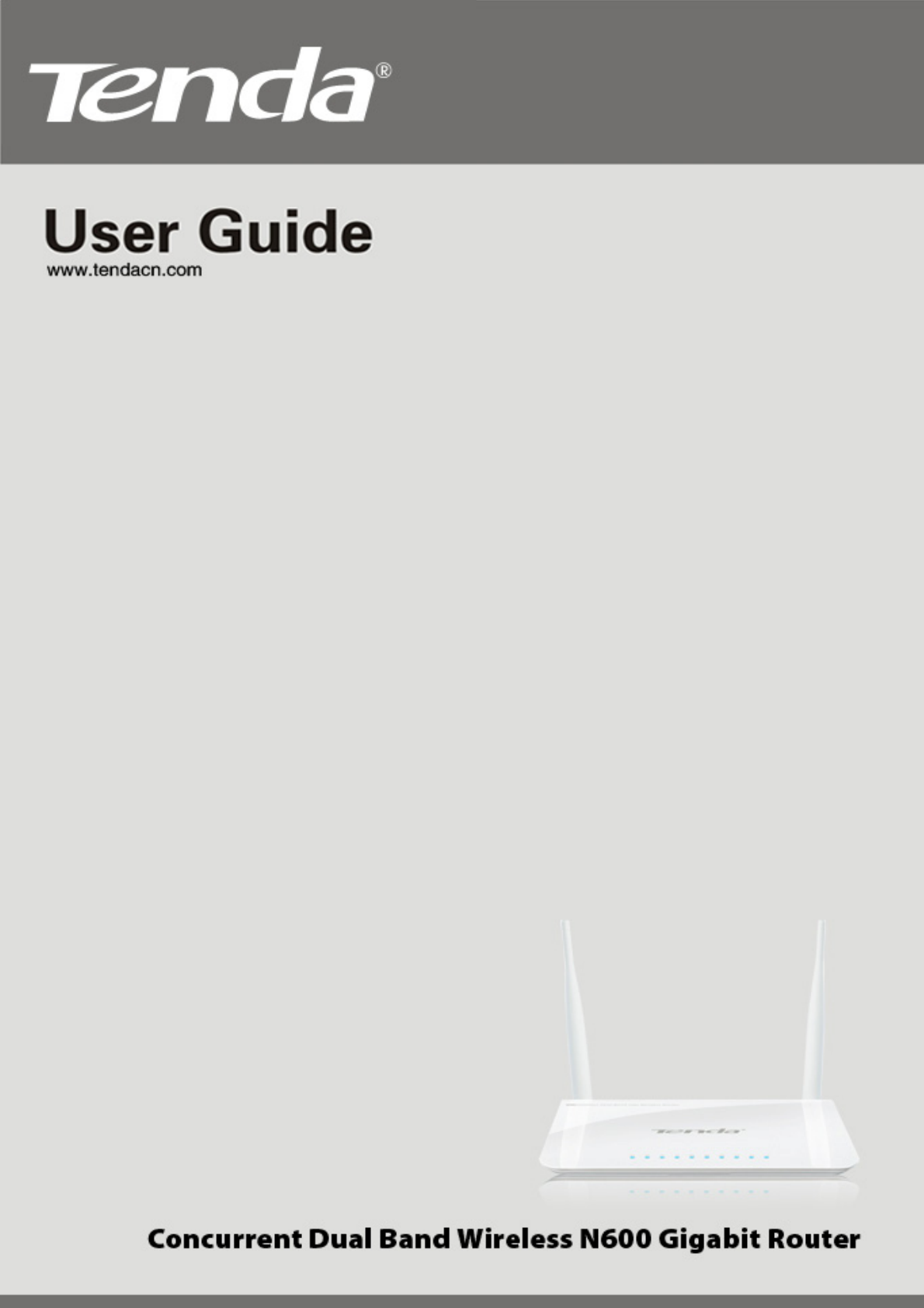
Concurrent Dual Band Wireless N600 Gigabit Router
1

Concurrent Dual Band Wireless N600 Gigabit Router
Copyright Statement
is the registered trademark of Shenzhen Tenda Technology Co., Ltd. All
the products and product names mentioned herein are the trademarks or
registered trademarks of their respective holders. Copyright of the whole product
as integration, including its accessories and software, belongs to Shenzhen Tenda
Technology Co., Ltd. Without prior expressed written permission from Shenzhen
Tenda Technology Co., Ltd, any individual or party is not allowed to copy, plagiarize,
reproduce, or translate it into other languages.
All photos and product specifications mentioned in this manual are for references
only. Upgrades of software and hardware may occur; Tenda reserves the right to
revise this publication and to make changes in the content hereof without
obligation to notify any person or organization of such revisions or changes. If you
would like to know more about our product information, please visit our website at
http://www.tendacn.com.
2

Concurrent Dual Band Wireless N600 Gigabit Router
Table of Contents
COPYRIGHT STATEMENT...............................................................................................2
CHAPTER 1 PRODUCT OVERVIEW ................................................................................4
1.1 WHAT IT DOES .....................................................................................................4
1.2 FEATURES............................................................................................................4
1.3 PACKAGE CONTENTS ...........................................................................................5
CHAPTER 2 HARDWARE................................................................................................6
2.1 PANEL OVERVIEW................................................................................................6
2.2 MINIMUM SYSTEM REQUIREMENTS ....................................................................7
2.3 HARDWARE INSTALLATION ..................................................................................7
CHAPTER 3 LOGIN TO WEB UTILITY .............................................................................9
CHAPTER 4 CONFIGURATIONS ...................................................................................11
4.1 DEVICE INFO .....................................................................................................11
4.2 NETWORK .........................................................................................................13
4.3 SECURITY SETTINGS..........................................................................................23
4.4 ADVANCED SETTINGS........................................................................................32
4.5 WIRELESS SETTINGS .........................................................................................39
4.6 USB APPLICATIONS...........................................................................................50
4.7 IPTV SETTINGS.................................................................................................59
4.8 TOOLS ...............................................................................................................60
A PPENDIX 1 CONFIG TCP/IP SETTINGS ON PC ..........................................................66
3

Concurrent Dual Band Wireless N600 Gigabit Router
Chapter 1 Product Overview
1.1 What it does
The Tenda N60 Concurrent Dual Band Wireless N600 Gigabit Router accommodates users
looking for extreme wireless performance. Delivering up to 300+300Mbps wireless speed, it
uses dual band technology to deliver 2.4GHz and 5GHz wireless signals simultaneously,
allowing you to check email and browse the Internet using the 2.4GHz while streaming
High-Definition movies and other bandwidth-intensive applications on the 5GHz band.
Also, it reduces the possibility of interference from appliances and cordless phones that
use the 2.4GHz band.
1.2 Features
2.4GHz:IEEE802.11n, IEEE802.11g,IEEE 802.11b;5GHz:IEEE 802.11n,IEEE
802.11a;IEEE802.3,IEEE802.3u;
Deliver 2.4GHz and 5GHz wireless signals simultaneously
1 Gigabit WAN port for Internet connection
3 Gigabit LAN ports for LAN connection
1 IPTV port
Up to 300+300Mbps wireless rate
Combines the function of a wireless AP, router, switch and firewall
Provides Internet connection types: Dynamic/ static IP,L2TP,PPTP,PPPOE/
PPPOE dual access
Supports IPTV service
1 USB port for storage or printer sharing
Built-in firewall supports domain name/MAC address filter
WEP, WPA-PSK, WPA2-PSK and WPA&WPA2-PSK secure your wireless network
against unauthorized access
Supports guest network
WPS one-touch encryption
Hidden/invisible SSID;
MAC-based access control
WMM streams your video and audio
Bandwidth control
SNTP, WDS, UPnP, DDNS and DMZ
Syslog records router's usage status
4

Concurrent Dual Band Wireless N600 Gigabit Router
1.3 Package Contents
Please unpack the box and check the following items:
N60 Concurrent Dual Band Wireless N600 Gigabit Router
Power Adapter
Quick Installation Guide
CD-ROM
1-meter Ethernet cable
If any of the above items are incorrect, missing, or damaged, please contact your Tenda
reseller for immediate replacement.
5
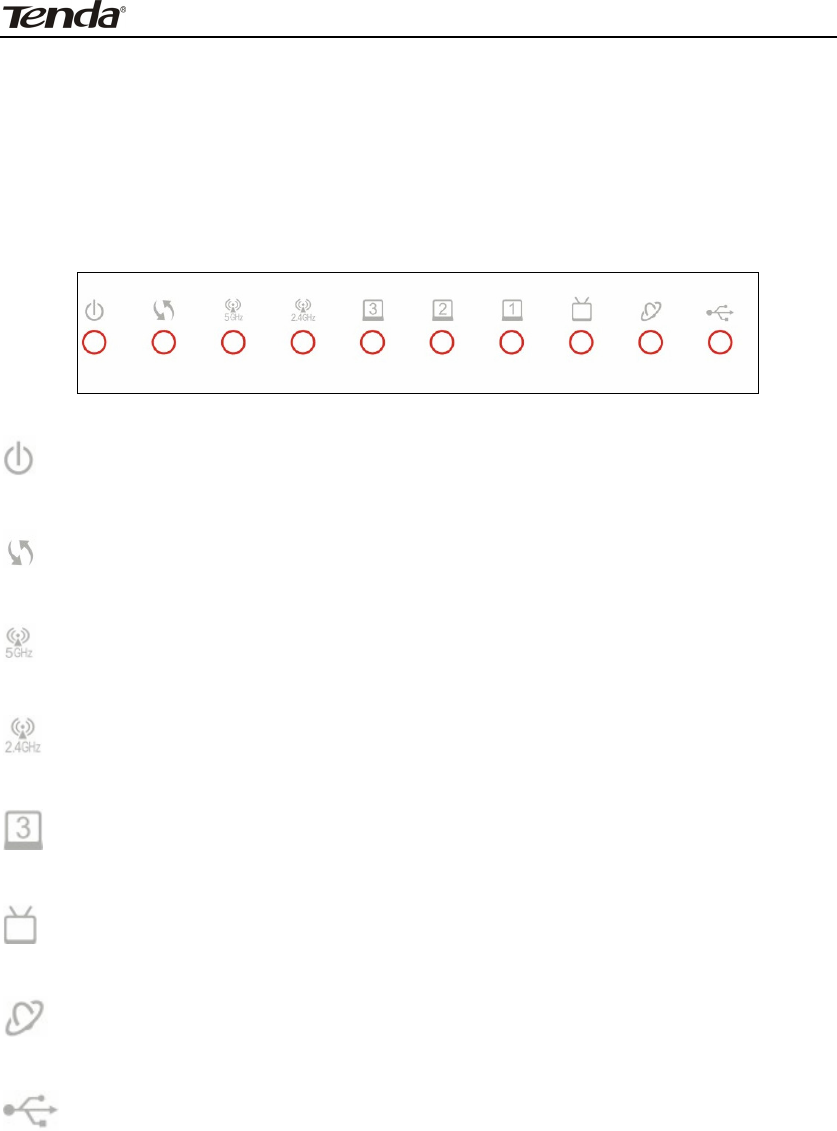
Concurrent Dual Band Wireless N600 Gigabit Router
Chapter 2 Hardware
2.1 Panel Overview
Front Panel
Power LED: A solid light indicates a proper connection to the power supply
while a blinking light indicates system is functioning correctly.
WPS LED: A blinking light indicates router is performing WPS authentication
on a client device.
5G LED: A solid light indicates wireless is active while a blinking light indicates
router is transmitting data wirelessly over 5GHz.
2.4G LED: A solid light indicates wireless is active while a blinking light
indicates router is transmitting data wirelessly over 2.4 GHz.
LAN/1/2/3 LED: A solid light indicates corresponding LAN port is correctly
connected while a blinking light indicates such port is transmitting data.
IPTV LED: A solid light indicates corresponding IPTV port is correctly
connected while a blinking light indicates it is transmitting data.
WAN LED: A solid light indicates the WAN port is correctly connected while a
blinking light indicates it is transmitting data.
USB LED: A solid light indicates the USB port is correctly connected.
6

Concurrent Dual Band Wireless N600 Gigabit Router
Back Panel
WAN: Internet port (RJ-45 )for connection to an Internet-enabled xDSL
Modem/Cable Modem or existing Ethernet.
IPTV:IPTV port for connection to a network set-top box. However such port can
function as a LAN port if IPTV STB port is not enabled.
LAN/1/2/3: 3 LAN ports (RJ-45) for connection to PC’s NIC or uplink to a hub,
switch or wireless AP.
WPS/Reset: WPS button/Reset button: Pressing it for about 1 second enables WPS
encryption with a blinking WPS LED while Pressing it for about 7 seconds restores
the device to factory defaults.
2.2 Minimum System Requirements
Installed Network Adapter
Internet Explorer 5.0 or higher
Broadband Internet Service (through xDSL/Cable Modem/Ethernet)
2.3 Hardware Installation
1. Connect one end of the included power adapter to the router and then plug
the other end into a wall outlet nearby. (Using a power adapter with a different
voltage rating than the one included with the router will cause damage to the
product.)
7
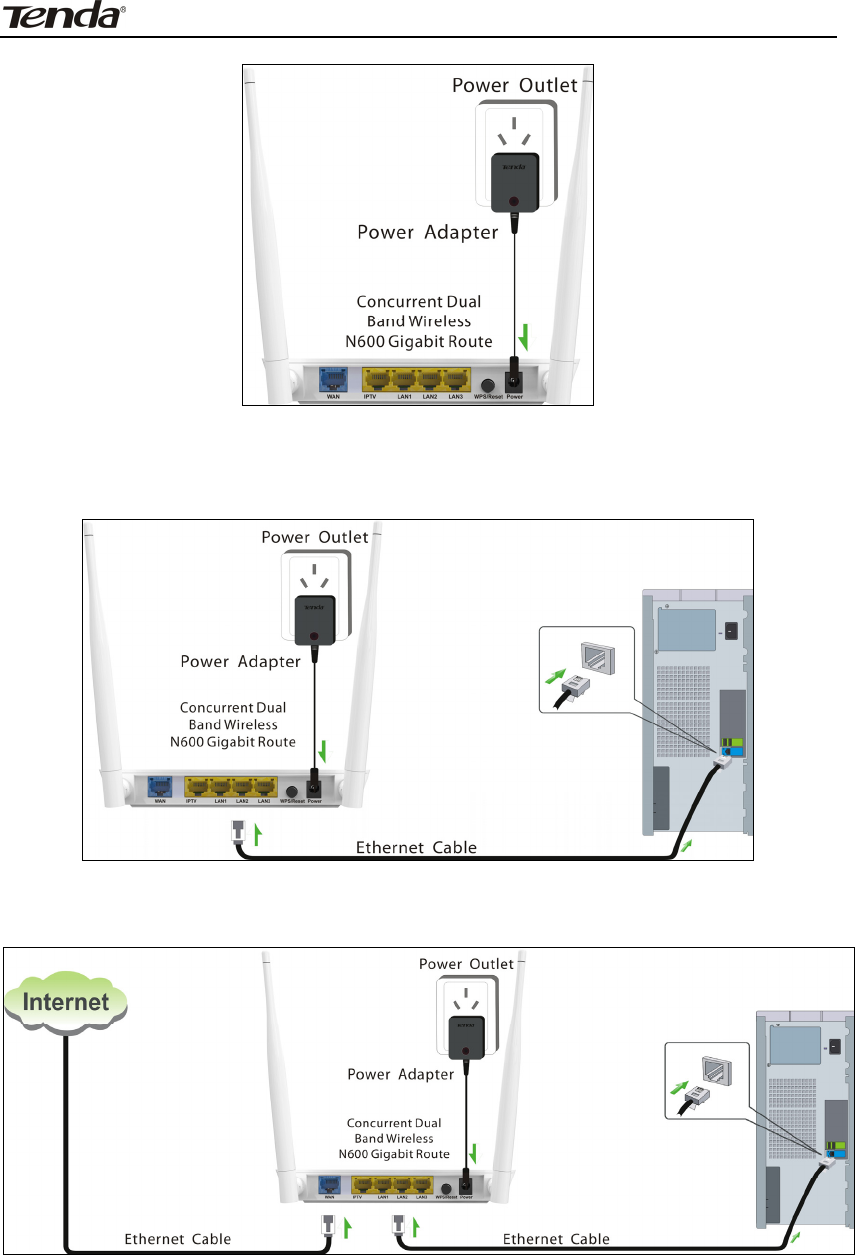
Concurrent Dual Band Wireless N600 Gigabit Router
2. Connect one of the LAN ports on the Router to the NIC port on your PC using an
Ethernet cable.
3. Connect the Ethernet cable from Internet side to the WAN port on the Router.
8
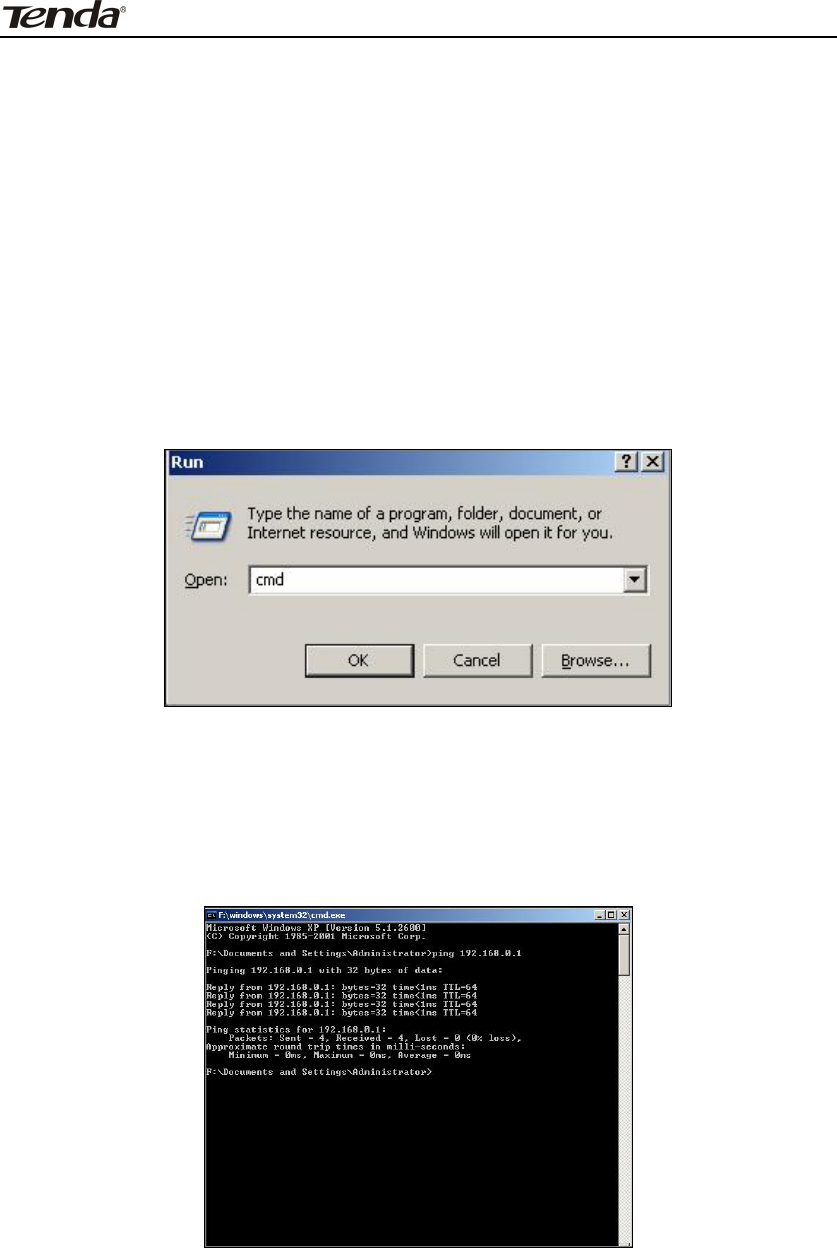
Concurrent Dual Band Wireless N600 Gigabit Router
Chapter 3 Login to Web Utility
The device’s default IP is 192.168.0.1. You can change it to accommodate your own
needs. Here in this manual, we use the default IP.
Connect you PC to the router and config your PC’s TCP/IP settings following
instructions in appendix 1 hereto. And then do as follows to run a Ping command
to test connectivity between your PC and the router.
1. Select “Start”—“Run” and enter “cmd”. Then press “Enter”.
Enter “ping 192.168.0.1” and press “Enter”. If you see the following screen, it
means the router is reachable on your PC. If you don’t get the following screen,
verify router’s power supply, Ethernet cable connections and your PC’s TCP/IP
settings.
9

Concurrent Dual Band Wireless N600 Gigabit Router
Login to web utility
Launch a web browser on your PC and enter http://192.168.0.1 as below. Then
press “Enter”.
Enter user name and password in corresponding fields on window below (Default
user name and password are respectively set to admin).
Note:
For security purpose, please change the default user name and password after you
logged in to web utility.
You will see the following interface if you entered a correct user name and a correct
password.
10
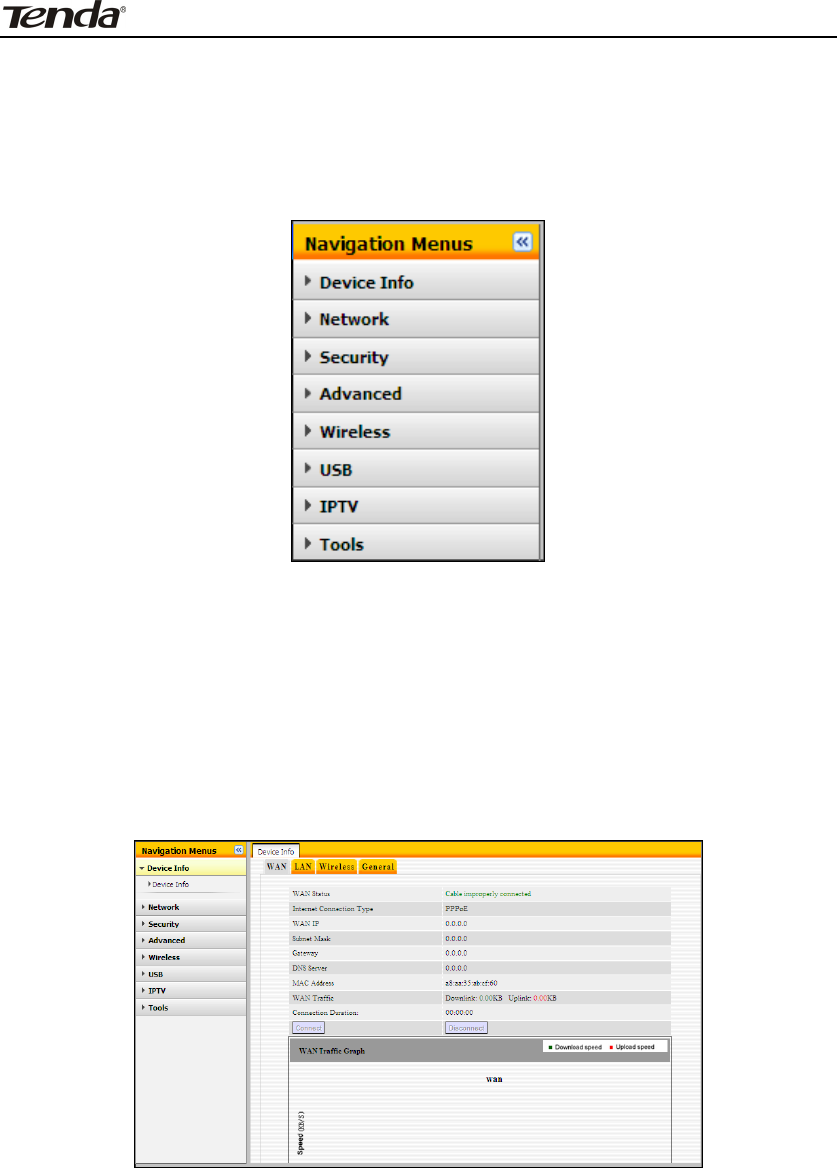
Concurrent Dual Band Wireless N600 Gigabit Router
Chapter 4 Configurations
This chapter delivers a detailed presentation of router’s functionalities and
features under 8 main menus below, allowing you to manage the router with ease.
During operation, if you are not clear about a certain feature, you can simply
click the “Help” button to read all related helpful info.
4.1 Device Info
WAN
This section allows you to view the router’s WAN info listed below:
WAN Status: Displays WAN connection status: Disconnected, Connecting or
Connected.
Disconnected: Indicates that the Ethernet cable from your ISP side is / is not
correctly connected to the WAN port on the router or the router is not logically
connected to your ISP.
Connecting: Indicates that the WAN port is correctly connected and is requesting
an IP address from your ISP.
11

Concurrent Dual Band Wireless N600 Gigabit Router
Connected: Indicates that the router has been connected to your ISP.
Internet Connection Type: Displays current Internet connection type.
WAN IP: Displays WAN IP address.
Subnet Mask: Displays WAN subnet mask.
Gateway: Displays WAN gateway address.
DNS Server: Displays WAN DNS address.
WAN MAC Address: Displays router’s WAN MAC address.
WAN Traffic: Displays bandwidth currently used by router in KB/s.
Connection Duration: Displays time duration indicating how long the router
has been connected to ISP.
WAN Traffic Graph: Displays a graphic presentation of the traffic flow.
LAN
This section allows you to view the router’s LAN info listed below:
IP Address:Displays LAN IP address.
Subnet Mask: Displays LAN subnet mask.
LAN MAC Address: Displays router’s LAN MAC address.
DHCP Server: Displays whether DHCP server is enabled or not.
NAT Entries/NAT: Displays number of used NAT entries and MAX NAT entries.
Wireless
This section allows you to view the wireless info listed below:
12
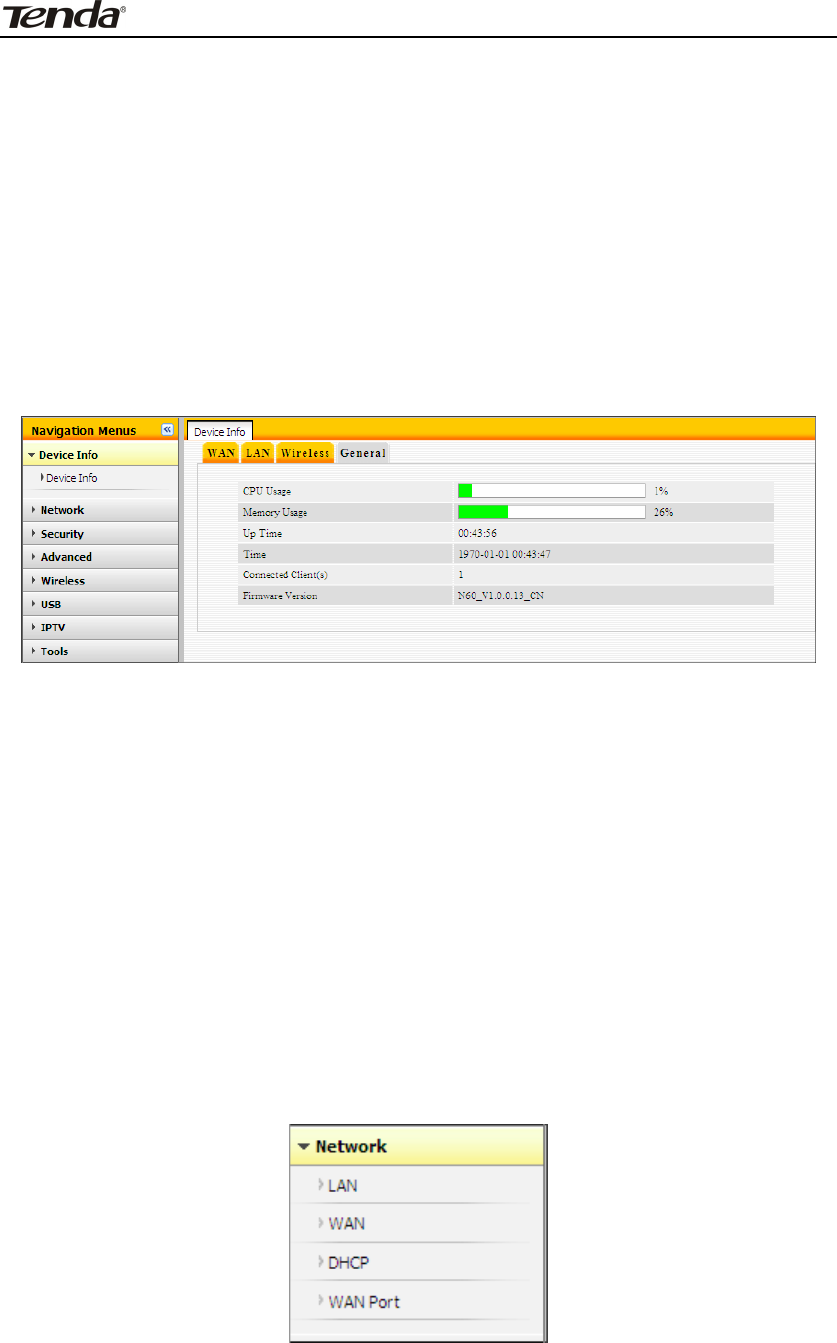
Concurrent Dual Band Wireless N600 Gigabit Router
Wireless Radio: Displays whether wireless is enabled or not.
Wireless MAC address: Displays MAC address of the router’s wireless interface.
SSID: Displays current SSID.
802.11 Mode: Displays currently active network mode.
Country: Displays current country.
Channel: Displays current channel.
Security Mode: Displays current security Mode.
System Info
This section displays CPU/memory usage, uptime, system time, number of
connected client(s) and system version info.
CPU Usage: Displays current CPU usage status.
Memory Usage: Displays current memory usage status.
Up Time: Displays uptime.
Time: Displays device’s time synchronized with Internet or manually set by
user.
Connected Client(s):Displays the number of connected computers.
Firmware Version:Displays router’s firmware version.
4.2 Network
“Network” includes the following four submenus. Clicking any of them enters
corresponding interface for configuration. Below explains, in details, each such
feature.
13
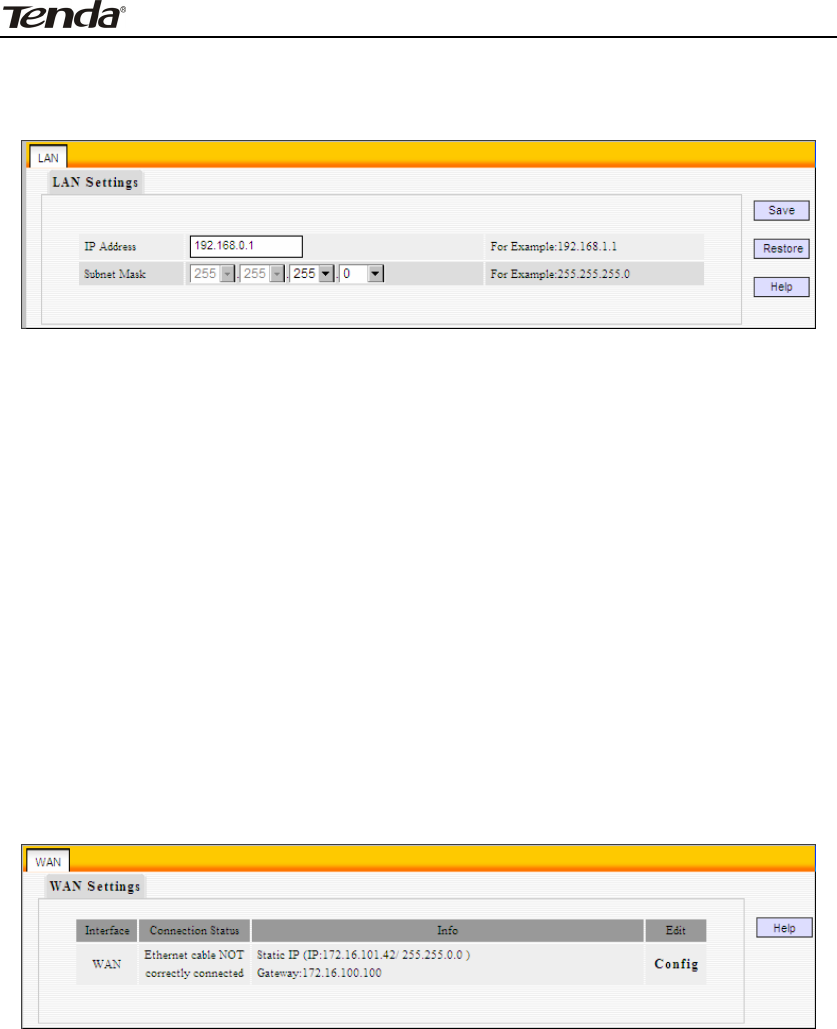
Concurrent Dual Band Wireless N600 Gigabit Router
4.2.1 LAN Settings
IP Address: Router’s LAN IP. The default is 192.168.0.1. You can change it
according to your need.
Subnet Mask: Router’s LAN subnet mask.
Note:
1. If you change the device’s LAN IP address, you must enter the new one in your
browser to get back to the web-based configuration utility. And LAN PCs’ gateway
must be set to this new IP for successful Internet connection.
2. WAN IP, whether obtained automatically or specified manually, should NOT be on
the same IP net segment as the LAN IP, otherwise, the router will not work properly.
In case of emergency, press the hardware "Reset" button.
4.2.2 WAN Settings
The screen below displays WAN connection status and interface info.
Click the “Config” button to enter WAN configuration interface. The router supports
six Internet connection types, include Dynamic IP, Static IP, L2TP, PPTP, PPPoE, and
PPPoE dual access.
1) Dynamic IP (DHCP): Select this option to let router obtain IP settings
automatically from your ISP, if your ISP does not give you any IP information or
account information. You don’t need to configure any settings for this connection.
14
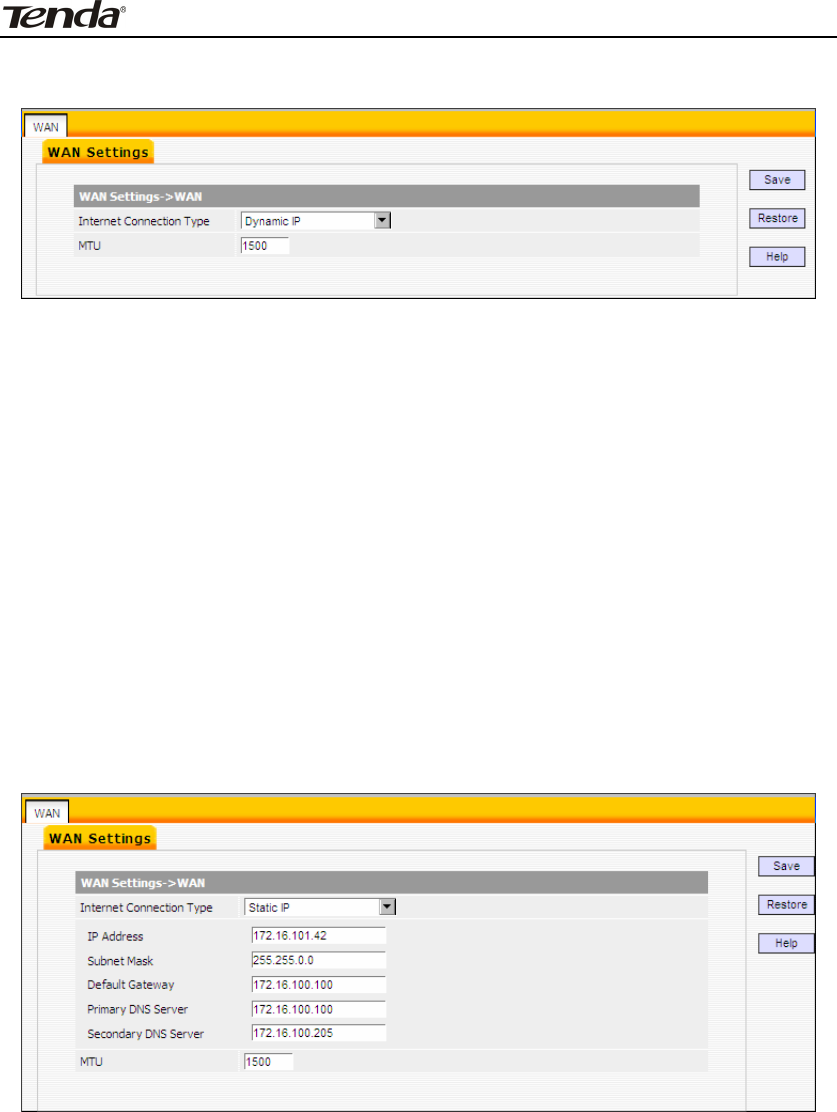
Concurrent Dual Band Wireless N600 Gigabit Router
¾ Internet connection Type: Displays a list of available Internet connection
types.
¾ MTU: Maximum Transmission Unit. The default value is1500.
Note:
DO NOT change the factory default MTU value unless necessary as an improper
MTU value may degrade your network performance or even lead to network
malfunction.
2) Static IP: If your ISP offers you static IP Internet connection type, select “Static IP"
from corresponding drop-down menu and then enter IP address, subnet mask,
Primary DNS and secondary DNS information provided by your ISP in
corresponding fields.
Internet connection Type: Displays a list of available Internet connection
types.
IP Address: Enter the WAN IP address provided by your ISP. Inquire your ISP if
you are not clear.
Subnet Mask: Enter WAN Subnet Mask provided by your ISP.
Default Gateway: Enter the WAN Gateway address provided by your ISP.
Primary DNS Server: Enter the necessary DNS address provided by your ISP.
Secondary DNS Server: Enter the other DNS address if your ISP provides you
with 2 such addresses, and it is optional.
15
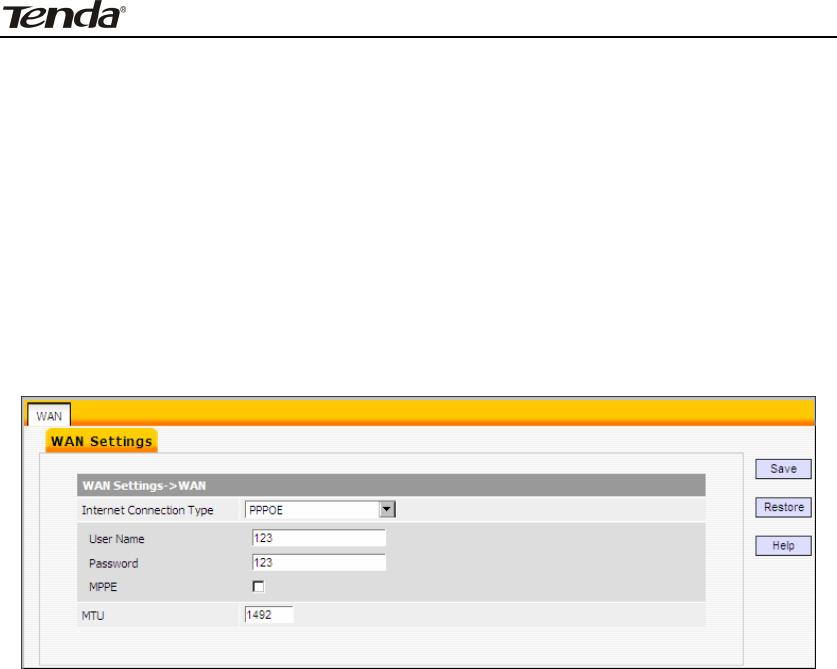
Concurrent Dual Band Wireless N600 Gigabit Router
MTU: Maximum Transmission Unit. The default value is1500.
Note:
DO NOT change the factory default MTU value unless necessary as an improper
MTU value may degrade your network performance or even lead to network
malfunction.
3) PPPoE: Select PPPoE, if your ISP is using a PPPoE connection and provide you
with PPPoE user name and password info.
Internet connection Type: Displays a list of available Internet connection
types.
User Name: Enter the User Name provided by your ISP.
Password: Enter the password provided by your ISP.
MTU: Maximum Transmission Unit. The default value is 1492.
Note:
DO NOT change the factory default MTU value unless necessary as an improper
MTU value may degrade your network performance or even lead to network
malfunction.
4)PPTP: Allows you to connect your router to a VPN server.
For example:A corporate branch and headquarter can use this connection type to
implement mutual and secure access to each other’s resources.
16

Concurrent Dual Band Wireless N600 Gigabit Router
Internet connection Type: Displays a list of available Internet connection
types.
PPTP Server IP: Enter the IP address of a PPTP server.
Username/Password: Enter Username/Password defined by the PPTP server.
Address mode: Select “Dynamic” if you don’t get any IP info from the PPTP
server side, otherwise select “Static”.
IP Address: Enter the IP address provided by your ISP. Inquire your local ISP if
you are not clear.
Subnet mask: Enter the subnet mask provided by your ISP.
Default Gateway: Enter the gateway provided by your ISP. Inquire your local
ISP if you are not clear.
DNS Server: Enter the necessary DNS address provided by your ISP.
Secondary DNS Server: Enter the other DNS address if your ISP provides you
with 2 such addresses, and it is optional.
MTU: Maximum Transmission Unit. The default value is 1450.
5)L2TP: Allows you to connect your router to a L2TP server.
For example:A corporate branch and headquarter can use this connection type to
implement mutual and secure access to each other’s resources.
17
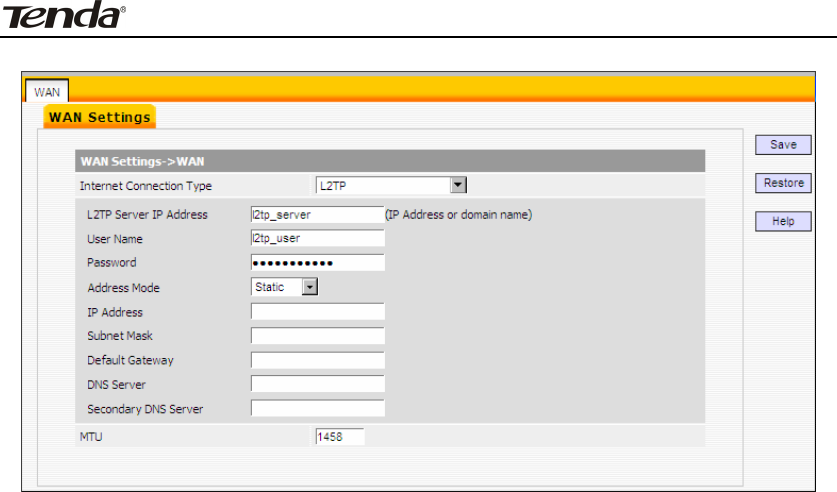
Concurrent Dual Band Wireless N600 Gigabit Router
Internet connection Type: Displays a list of available Internet connection
types.
L2TP Server IP Address: Enter the IP address of a L2TP server.
Username/Password: Enter Username/Password specified by the L2TP server.
Address Mode: Select “Dynamic” if you don’t get any IP info from the L2TP
server, otherwise select “Static”.
IP address: Enter the IP address provided by your ISP. Inquire your local ISP if
you are not clear.
Subnet mask: Enter the subnet mask provided by your ISP.
Default Gateway: Enter the gateway provided by your ISP. Inquire your local
ISP if you are not clear.
DNS Server: Enter the necessary DNS address provided by your ISP.
Secondary DNS Server: Enter the other DNS address if your ISP provides you
with 2 such addresses, and it is optional.
MTU: Maximum Transmission Unit. The default value is 1450.
18

Concurrent Dual Band Wireless N600 Gigabit Router
6) PPPOE Dual Access
Internet connection Type: Displays a list of available Internet connection
types.
Username: Enter the PPPOE account provided by your ISP.
Password: Enter the PPPOE password provided by your ISP.
Address mode: Select “Dynamic” if you don’t get any IP info from your ISP,
otherwise select “Static”.
IP address: The IP address provided by your ISP. Inquire your local ISP if you are
not clear.
Subnet mask: The subnet mask provided by your ISP.
Default Gateway: The gateway address provided by your ISP. Inquire your local
ISP if you are not clear.
MTU: Maximum Transmission Unit. The default value is 1492.
4.2.3 DHCP Settings
“DHCP” includes 3 submenus: DHCP Server, Client List and Static Assignment.
Clicking any of them enters corresponding interface for configuration. Below
explains, in details, each such feature.
The Dynamic Host Configuration Protocol (DHCP) is an automatic configuration
protocol used on IP networks. If you enable the built-in DHCP server on the device,
it will automatically configure the TCP/IP settings for all your LAN computers
(including IP address, subnet mask, gateway and DNS etc), eliminating the need for
manual intervention. Just be sure to set such PCs to DHCP clients by selecting
“Obtain an IP Address Automatically” on each such PC. When you turn these PCs on,
they will automatically load the proper TCP/IP settings provided by the device
DHCP server.
19
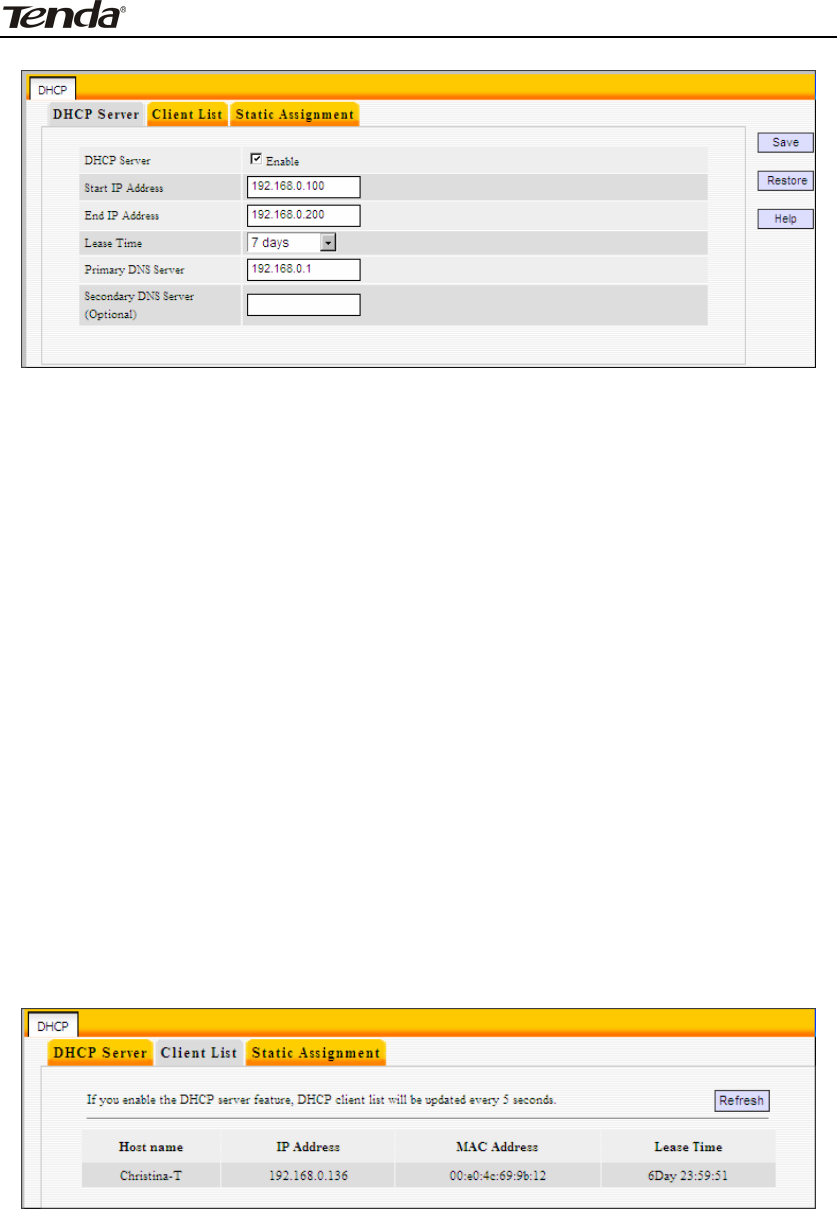
Concurrent Dual Band Wireless N600 Gigabit Router
DHCP Server-Enable: Check or uncheck the box to enable or disable the
device’s DHCP server feature.
Start IP Address: Enter the starting IP address for the DHCP server’s IP
assignment.
End IP Address: Enter the ending IP address for the DHCP server’s IP
assignment.
Lease Time: The length of time for the IP address lease. Configuring a proper
lease time improves the efficiency for the DHCP server to reclaim disused IP
addresses.
Primary DNS Server: Enter a DNS server address assigned to DHCP clients.
Secondary DNS Server: Enter the other DNS address assigned to DHCP clients
(optional).
To benefit from the DHCP server feature, you must set all LAN PCs to DHCP clients
by selecting the “Obtain an IP Address Automatically” radio buttons thereon.
DHCP Client List
This section displays a DHCP dynamic client list, which includes host name, IP
address, MAC address and lease time info.
IP Address: Displays IP address(s) that client(s) obtained from the DHCP server.
MAC Address: Displays MAC address of a given host.
Host name: Displays name of a given host (DHCP client).
Lease Time: Remaining time for a corresponding IP address lease.
20
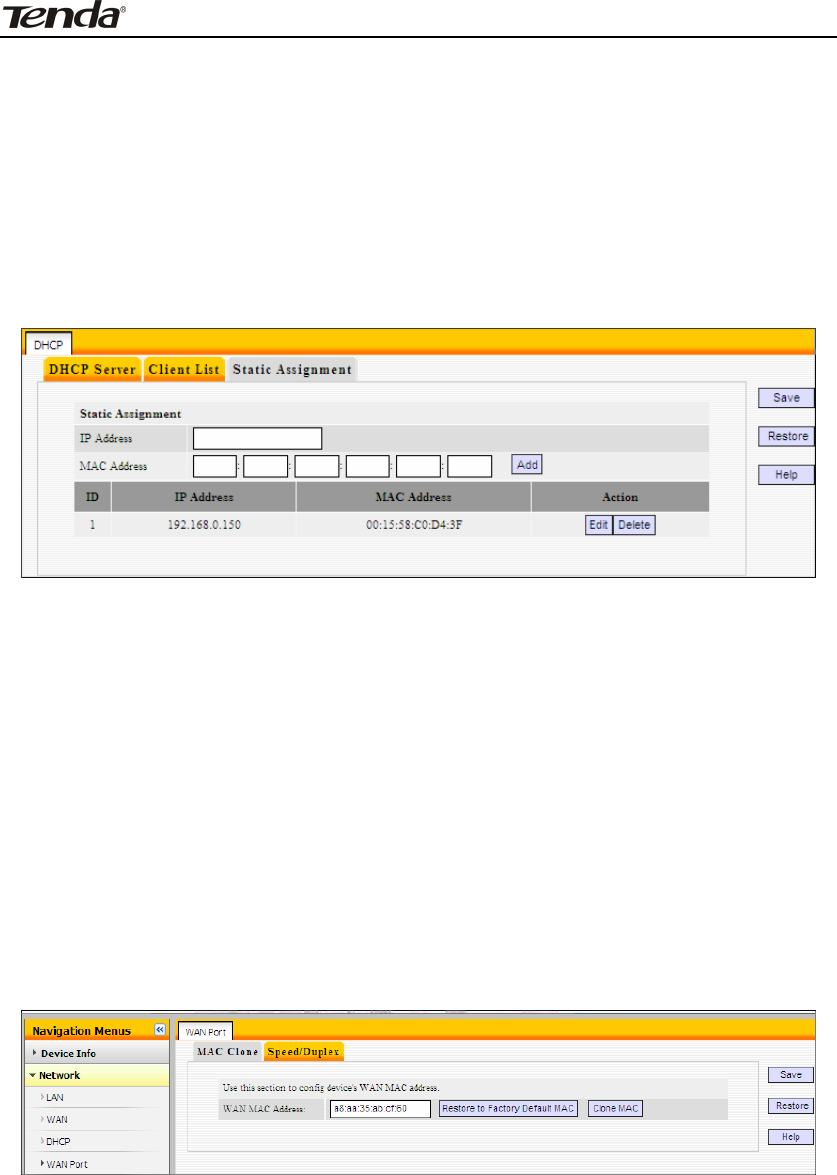
Concurrent Dual Band Wireless N600 Gigabit Router
Static Assignment
If you would like some devices on your network to always have fixed IP addresses,
you can use this feature and manually add a static DHCP assignment entry for each
such device.
For example: To have a PC at the MAC address of 00:15:58:c0:d4:3f always receive
the same IP address of 192.168.0.150, simply enter the IP and MAC addresses in
corresponding fields and click “Add” and then the “Save” button as shown below.
IP Address: Enter the IP address for static DHCP assignment.
MAC Address: Enter the MAC address of a computer to always receive the same
IP address (the IP you just entered above).
Add: Click to add the current IP-MAC static assignment entry to the list.
Edit: Click to change a given static assignment entry.
Delete: Click to remove an existing entry.
4.2.4 WAN Port
“WAN Port” includes 2 submenus: MAC Clone, and Speed/Duplex. Clicking either
tab enters corresponding interface for configuration. Below explains, in details,
each such feature.
MAC Clone
This section allows you to set router’s WAN MAC address. You can either manually
enter a MAC or copy your PC’s MAC to the router.
21
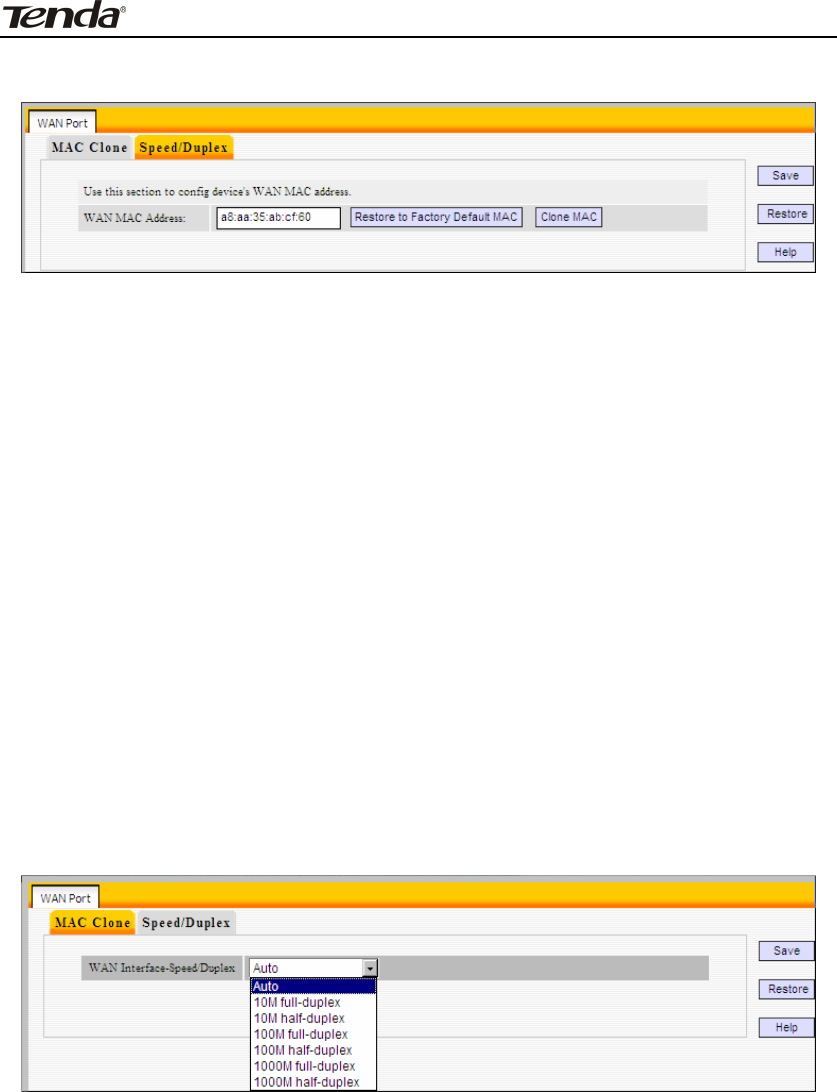
Concurrent Dual Band Wireless N600 Gigabit Router
WAN MAC Address: Displays router's current WAN MAC address, you can
manually change it.
Restore to Factory Default MAC: Click it to restore router’s WAN MAC to factory
default value.
Clone MAC: Click to copy your PC’s MAC to router’s WAN MAC Address field.
NOTE:
1. Normally you don't need to change the default WAN MAC value. However, some
ISP may bind client PC’s MAC address for Internet connection authentication. In this
case, simply enter such MAC in the WAN MAC Address field or click the “Clone MAC”
button. Note that the WAN MAC address in running status interface will be updated
accordingly.
2. Do remember to reboot the router to activate the new WAN MAC. DO NOT use
the “Clone MAC” feature if your ISP does not bind your PC’s MAC.
Speed/Duplex
This section allows you to config the router’s WAN port speed/duplex settings.
You can select a WAN port speed/duplex mode that best suit your network
environment from the drop-down list, which includes auto, 10M half-duplex, 10M
full-duplex, 100M half-duplex, 100M full-duplex, 1000M half-duplex and 1000M
full-duplex.
Note:
The WAN port speed/duplex mode must match that of its link partner to achieve
successful communication; otherwise, the WAN port may not function properly. So,
if you are not sure about the link partner’s speed/duplex mode, please select “Auto”.
22
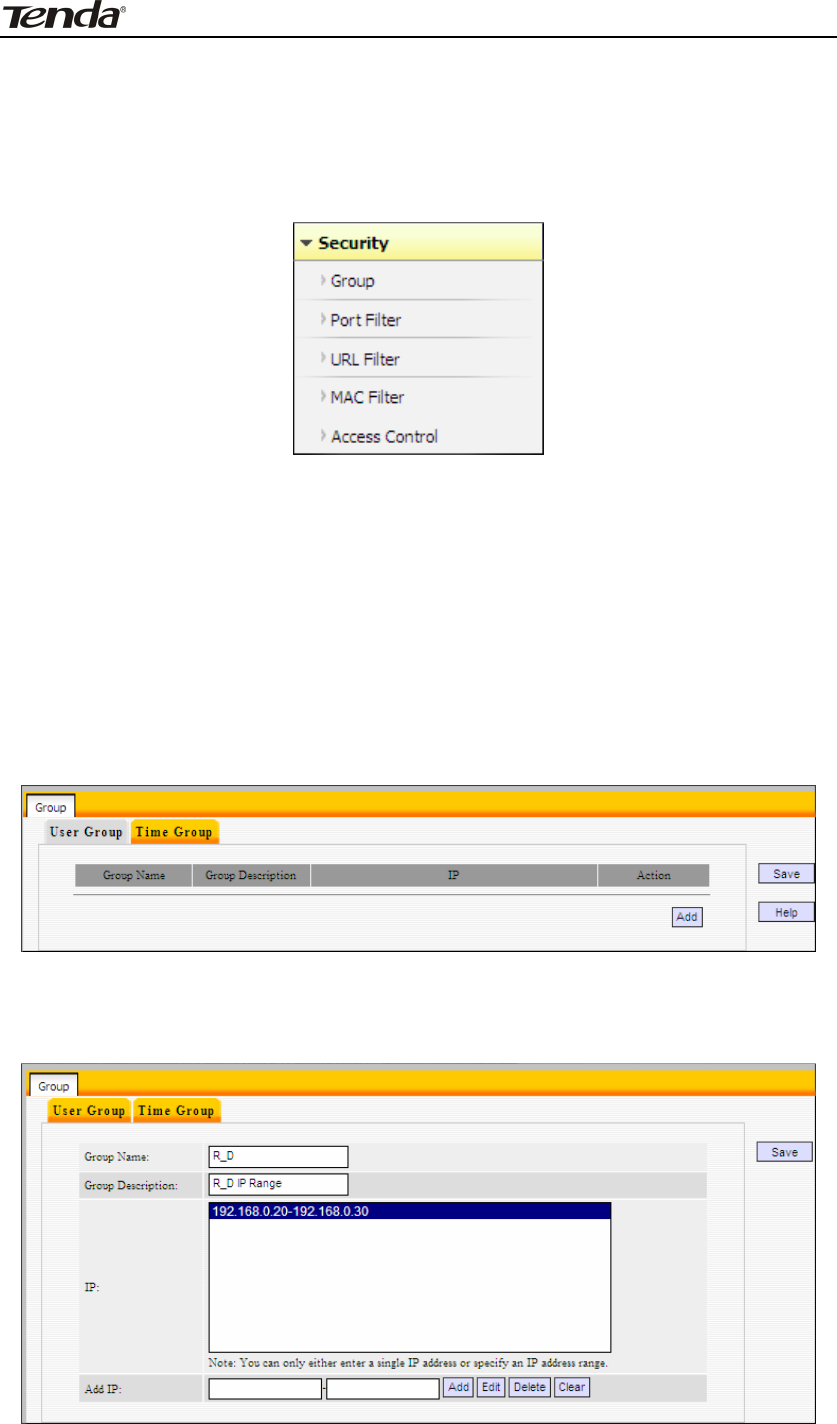
Concurrent Dual Band Wireless N600 Gigabit Router
4.3 Security Settings
“Security Settings” includes the following 5 submenus. Clicking any of them
enters corresponding interface for configuration. Below explains, in details, each
such feature.
4.3.1 Group Settings
“Group Settings” includes 2 submenus: Group Settings, User Group and Time
Group. Clicking either tab enters corresponding interface for configuration. Below
explains, in details, each such feature.
User Group
To create a user group, you need to specify a group name/description and an
IP address/range. The user group feature works together with other related
features.
For example: If you want to add a user group for a R&D department within an IP of
192.168.0.20-192.168.0.30, first click the “Add” button and then follow steps below:
23

Concurrent Dual Band Wireless N600 Gigabit Router
1. Enter R_D in group name field.
2. Enter R_D IP Range in group description field.
3. Enter “192.168.0.20” and “192.168.0.30” in IP fields.
4. Click “Add “and then the “Save “button; you will find
such entry in User Group list below:
Time Group
To create a time group, you need to specify a group name/description and a time /
time range.
For example: If you want to set a period of time from 8:00 to 18:00 on working
days from Monday to Friday to a time group, first click the “Add” button and then
follow steps below:
24

Concurrent Dual Band Wireless N600 Gigabit Router
1. Enter “Working days” in group name field.
2. Enter “working days” in group description field.
3. Select the time and days.
4. Click “Save” and you will find such entry in Time Group list below:
4.3.2 Port Filter
To better manage PCs in LAN, you can allow or disallow such PCs to access certain
ports on Internet using the Port Filter functionality.
Click “Add” to enter page below:
Filter Mode: Select Deny or Allow according to your own needs.
25
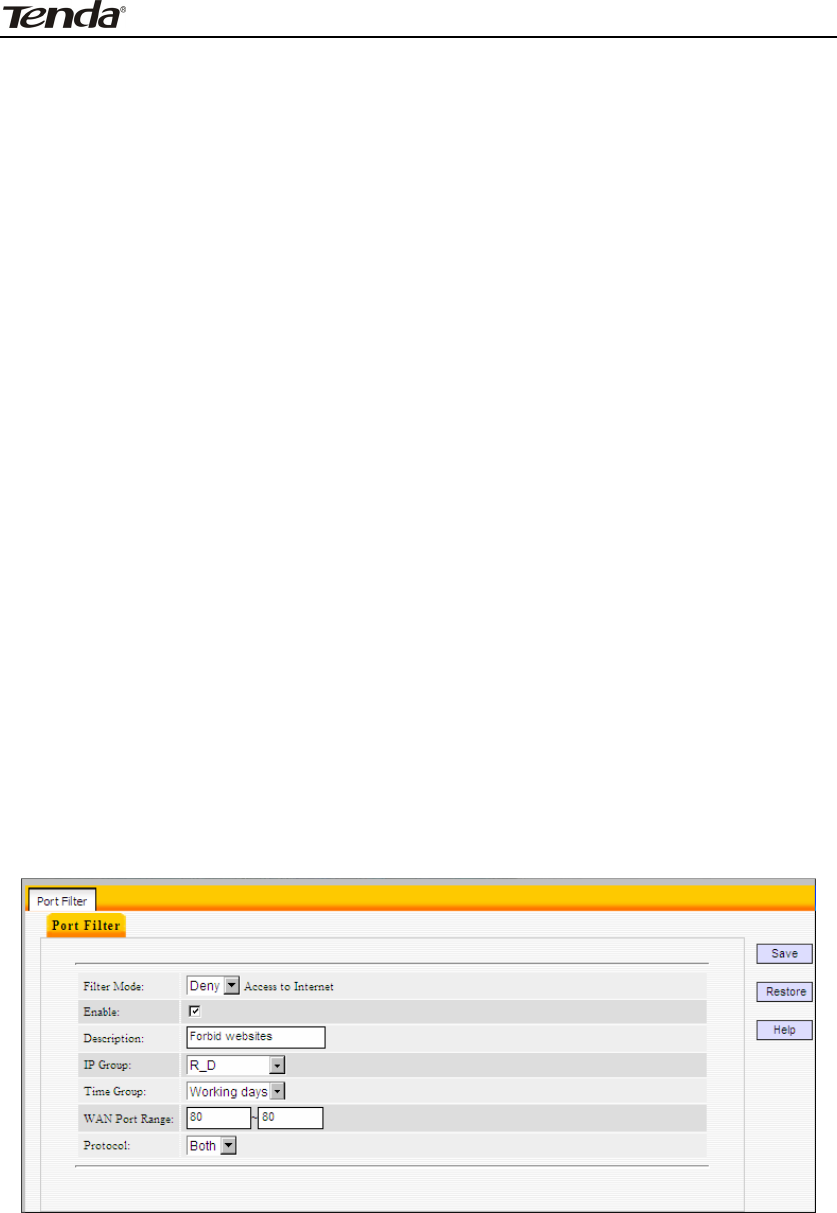
Concurrent Dual Band Wireless N600 Gigabit Router
Deny Access to Internet: Disallow specified packets to pass through the router;
other packets are processed according to default rule.
Allow Access to Internet: Allow specified packets to pass through the router;
other packets are processed according to default rule.
Enable: Check to enable current filter entry.
Description: Enter a meaningful name to yourself for a new filter rule.
User Group: Select an added user group from the drop-down list.
Time Group: Select an added time group from the drop-down list.
WAN Port Range: Enter port IDs. You can specify a range of ports or a single
port. Allowed port ID ranges from 1 to 65535.
Protocol: Select a protocol or protocols for the traffic (“Both” includes TCP and
UDP).
For Example: If you want to disallow PCs within IP addresses ranging from
192.168.0.20 to 192.168.0.30(“R&D” user group) to access web sites from 8:00 to
18:00 on working days – from Monday to Friday (“Working days” time group), do as
follows:
1. Select “Deny” from the filter mode drop-down list.
2. Check the “Enable” box.
3. Enter “Forbid websites” in description field.
4. Select “R&D” from the user group drop-down list.
5. Select “Working days” from time group drop-down list.
6. Enter “80” in both boxes of “WAN Port Range”.
7. Select “Both” from “Protocol” drop-down list.
8. Click “Save” and you will find such entry in the List below.
26
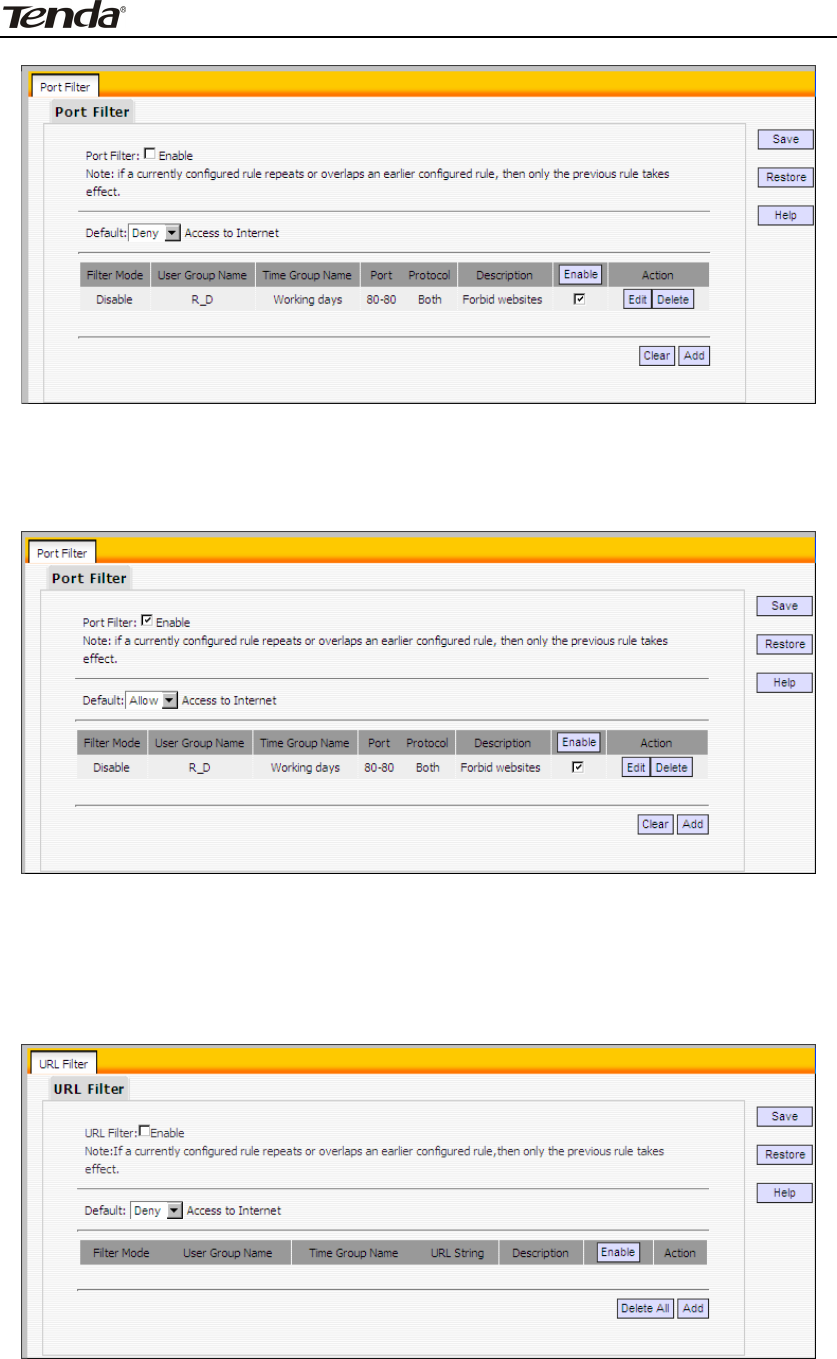
Concurrent Dual Band Wireless N600 Gigabit Router
9. Select “Allow” from the “Default” drop-down list and check “Enable” Port Filter
feature.
4.3.3 URL Filter
To better control LAN PCs, you can use the URL filter functionality to allow or
disallow such PC to access certain websites within a specified time range.
Click “Add” to display page below:
27

Concurrent Dual Band Wireless N600 Gigabit Router
Filter Mode: Select Deny or Allow according to your own needs.
Deny Access to Internet: Disallow specified packets to pass through the router; other
packets are processed according to default rule.
¾ Allow Access to Internet: Allow specified packets to pass through the router; other
packets are processed according to default rule.
¾ User Group: Select an added user group from drop-down list.
¾ Time Group: Select an added time group from drop-down list.
¾ Description: Enter a meaningful name to yourself for a new filter rule.
¾ URL character string: Enter domain name string to be filtered.
For Example: If you want to disallow PCs within IP addresses ranging from 192.168.0.20
to 192.168.0.30(“R_D” user group) to access only web sites containing “yahoo” from 8:00 to
18:00 on working days – from Monday to Friday (“Working days” time group), without
restricting other PCs, do as follows:
1. Select “Deny” from the filter mode drop-down list.
2. Check the “Enable” box.
3. Enter “Disallow yahoo” in description field.
4. Select “R_D” from the user group drop-down list.
5. Select “Working days” from time group drop-down list.
6. Enter “yahoo” in URL String field.
28
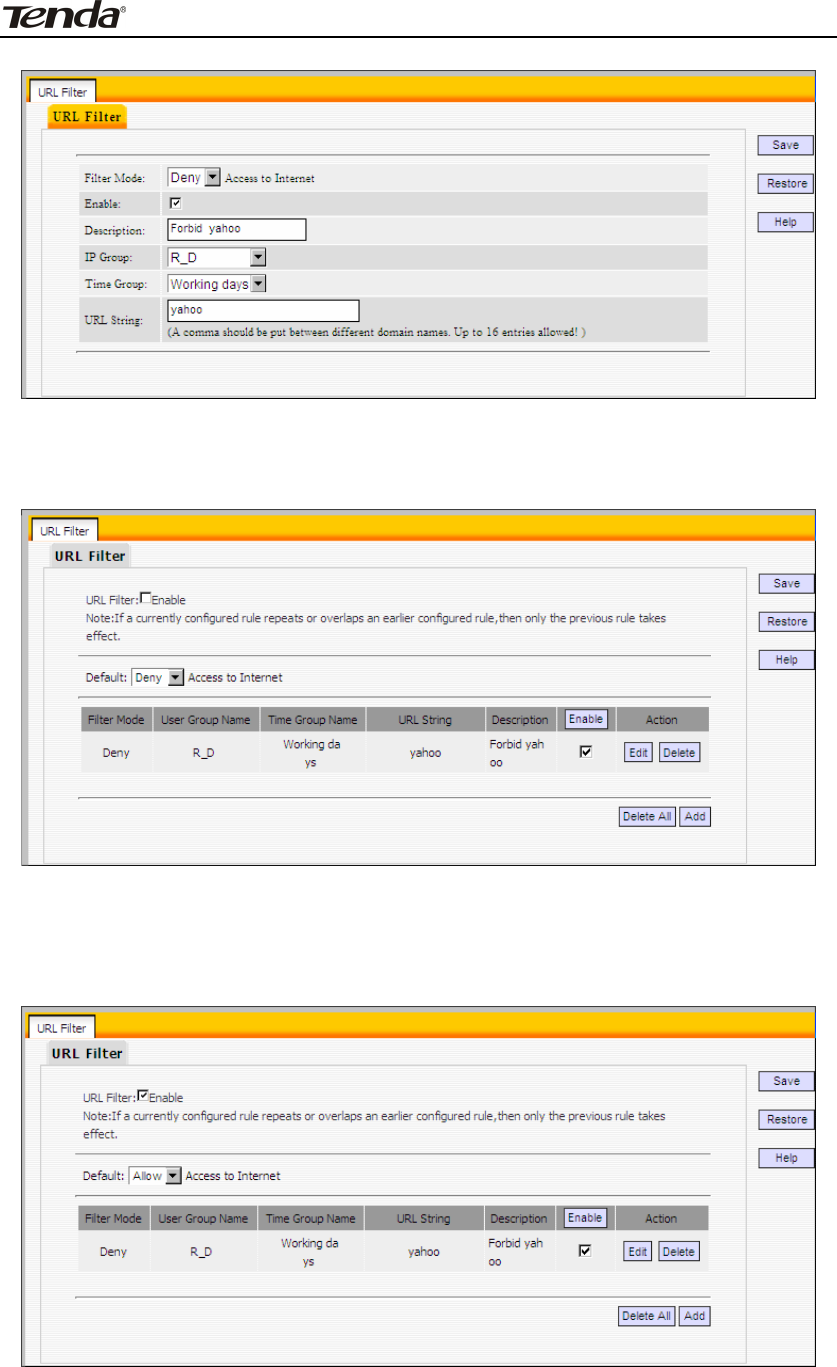
Concurrent Dual Band Wireless N600 Gigabit Router
7. Click “Save” to display page below:
8. Select “Allow” from the “Default” drop-down list and check the “Enable” URL Filter
feature.
29
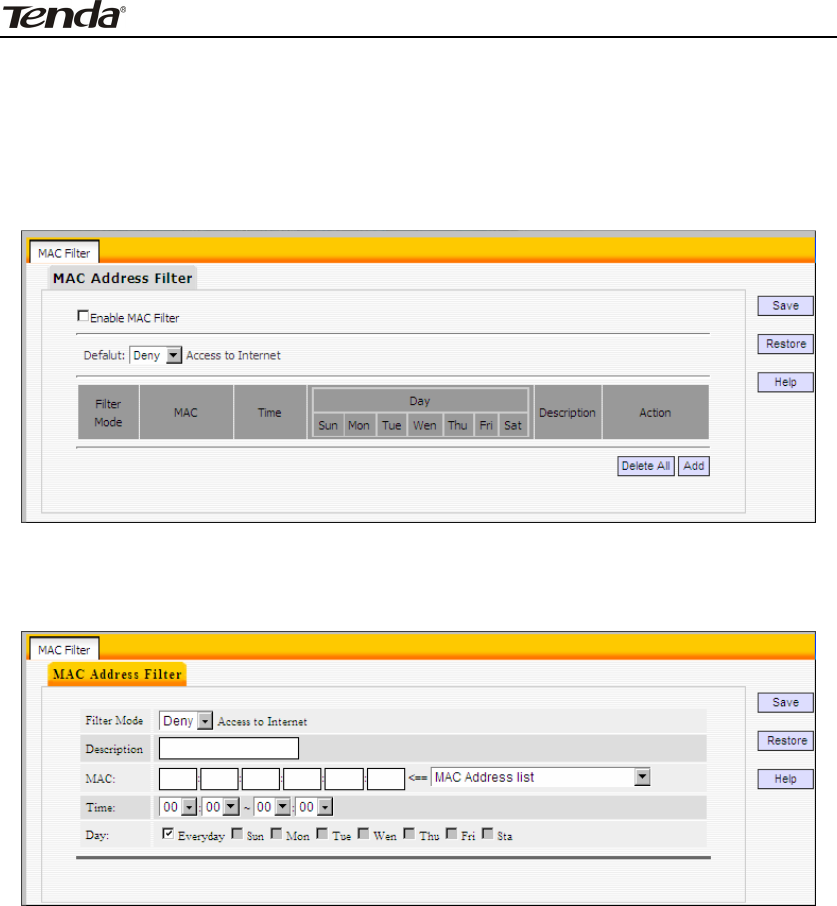
Concurrent Dual Band Wireless N600 Gigabit Router
4.3.4 MAC Address Filter
To better manage PCs in LAN, you can use the MAC Address Filter function to
allow/disallow such PCs to access to Internet.
Click “Add” to display page below:
Filter Mode: Select Deny or Allow according to your own needs.
Deny Access to Internet: Disallow specified packets to pass through the router;
other packets are processed according to default rule.
Allow Access to Internet: Allow specified packets to pass through the router;
other packets are processed according to default rule.
Description: Briefly describe a new filter rule
MAC: Enter the computer’s MAC address that you want to filter out in the MAC
address field or select one from the MAC address list.
Time: Select a time range for the new MAC address filter rule to take effect. The
default is 00:00-00:00, which means 24 hours.
Day: select a day or several days for the new MAC address filter rule to take
effect.
For Example: To only prevent a PC at the MAC address of 00:B0:0C:77:88:00 from
accessing Internet from 8:00 to 18:00 everyday, without restricting other PCs,
config same settings on the screenshot below on your device:
30

Concurrent Dual Band Wireless N600 Gigabit Router
Click “Save” to display the following page. Select “Allow” from the “Default”
drop-down list and check the “Enable MAC Filter” feature as below.
4.3.5 WAN Access Control
The WAN Access Control feature allows users to configure your router from Internet
via a web browser.
Enable: Check or uncheck to enable or disable the WAN Access Control feature.
Port: Enter a port ID for remote web-based management. The default is 8080.
IP Address: Enter the IP address of a PC on Internet authorized to access and
manage your router’s web-based utility remotely.
31
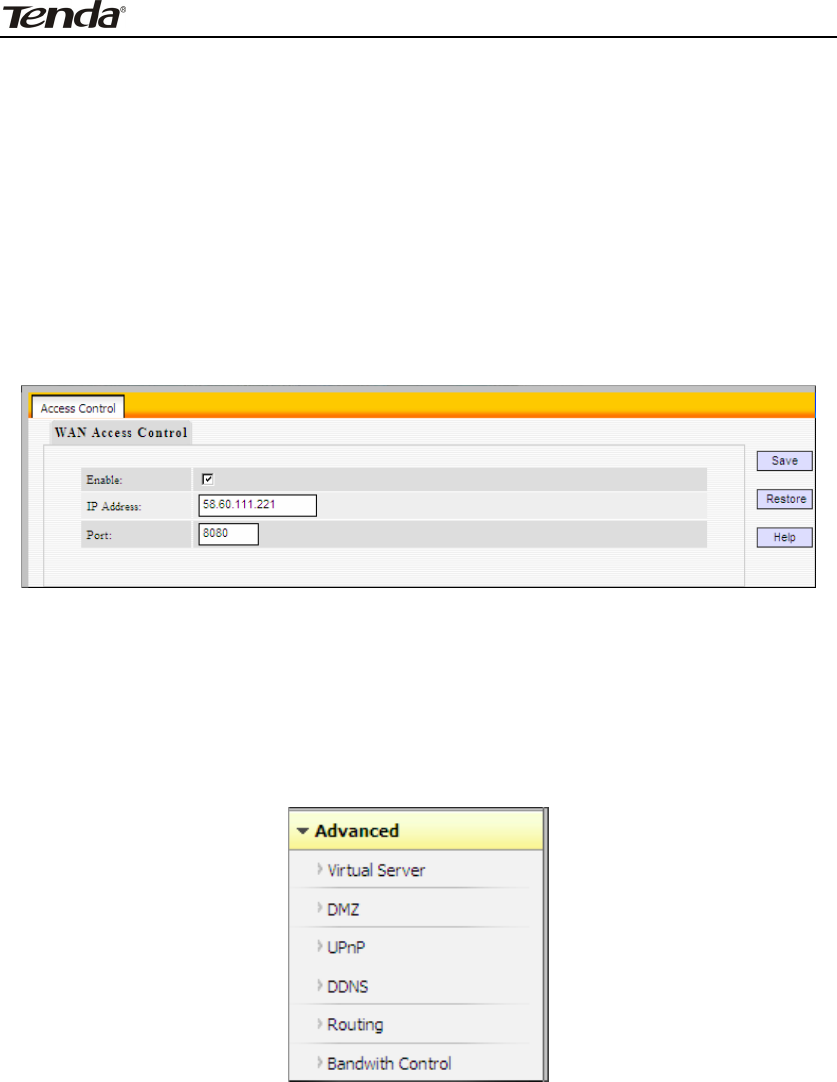
Concurrent Dual Band Wireless N600 Gigabit Router
Note:
If you enter 0.0.0.0 in the IP address box, then all PCs on Internet can access your
router’s Web-based utility to view or change your settings remotely once you
enable the feature.
For example: If you want to allow only a PC at the IP address of 58.60.111.221 to
access your router’s web-based utility from Internet via port: 8080, you need to
configure same settings as shown on the interface below on your router. And what this
IP user needs to do is to simply launch a browser and enter http://58.251.88.90:8080
(provided that your router’s WAN IP address is 58.251.88.90).
4.4 Advanced Settings
“Advanced Settings” includes the following 6 submenus. Clicking any of them
enters corresponding interface for configuration. Below explains, in details, each
such feature.
4.4.1 Virtual Server
The Virtual Server feature grants Internet users access to services on your LAN. It is
useful for hosting online services such as FTP, Web, or game servers. For each
Virtual Server, you define a WAN port on your router for redirection to an internal
LAN IP Address and LAN port.
32

Concurrent Dual Band Wireless N600 Gigabit Router
Click “Add” to display below page.
WAN Port: Enter the WAN service port.
Well-Known Service Ports: The “Well-Known Service Port” lists commonly used
protocol ports such as DNS(53, FTP(21), GOPHER(70), HTTP(80), NNTP(1190),
POP3(110), PPTP(1723) , SMTP(25), SOCK(1080), TELNET(23). In case that you
don’t find the port ID you need, add it manually.
LAN Port: Enter LAN service port.
LAN IP: The IP address of a computer used as a server in LAN.
Protocol: Includes TCP, UDP and Both. Select “Both” if you are not sure about
which protocol to use.
Enable: Check the “Enable” option to activate corresponding entry.
For example: If you create a web server using port 80 on a LAN PC at the IP address
of 192.168.0.10, and you want WAN users to access such server via
http://x.x.x.x:4000 (x.x.x.x represents router’s WAN IP address), then do as follows:
1. Enter “4000” in WAN Port field, 80 in LAN port field and 192.168.0.10 in Private IP
field,
2. Select “Both” from protocol drop-down list.
3. Check the “Enable” box.
4. Click “Save” to save such settings.
33
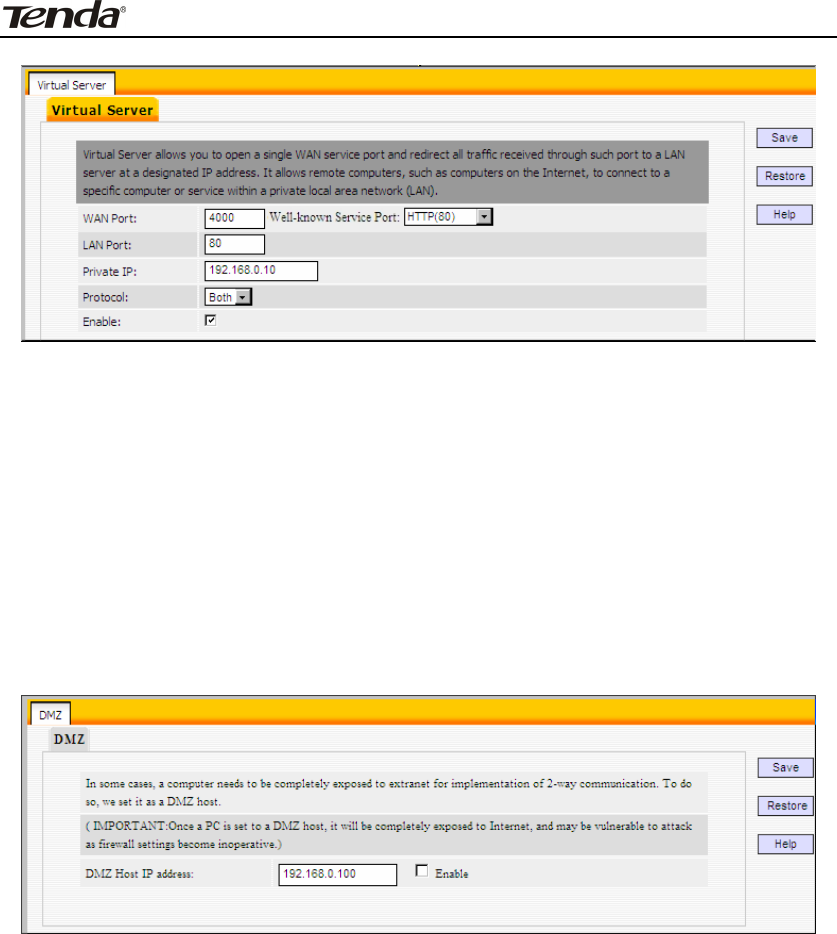
Concurrent Dual Band Wireless N600 Gigabit Router
Note:
Setting WAN port hereon to the same value as that on WAN access control section
will deactivate the virtual server feature.
4.4.2 DMZ Settings
In some cases, we need to set a computer to be completely exposed to extranet for
implementation of a bidirectional communication. To do so, we set it as a DMZ
host.
DMZ Host IP Address: Enter the IP address of a LAN computer which you want
to set to a DMZ host.
Enable: Check/uncheck to enable/disable the DMZ host.
NOTE:
1. If you set a PC to a DMZ host, it will be completely exposed to extranet and gains
no more protection from the device firewall.
2. A WAN user accesses the DMZ host through a corresponding WAN IP address.
4.4.3 UPnP Settings
UPnP (Universal Plug and Play) requires Windows ME/Windows XP or later or
application softwares that support such UPnP feature.
34
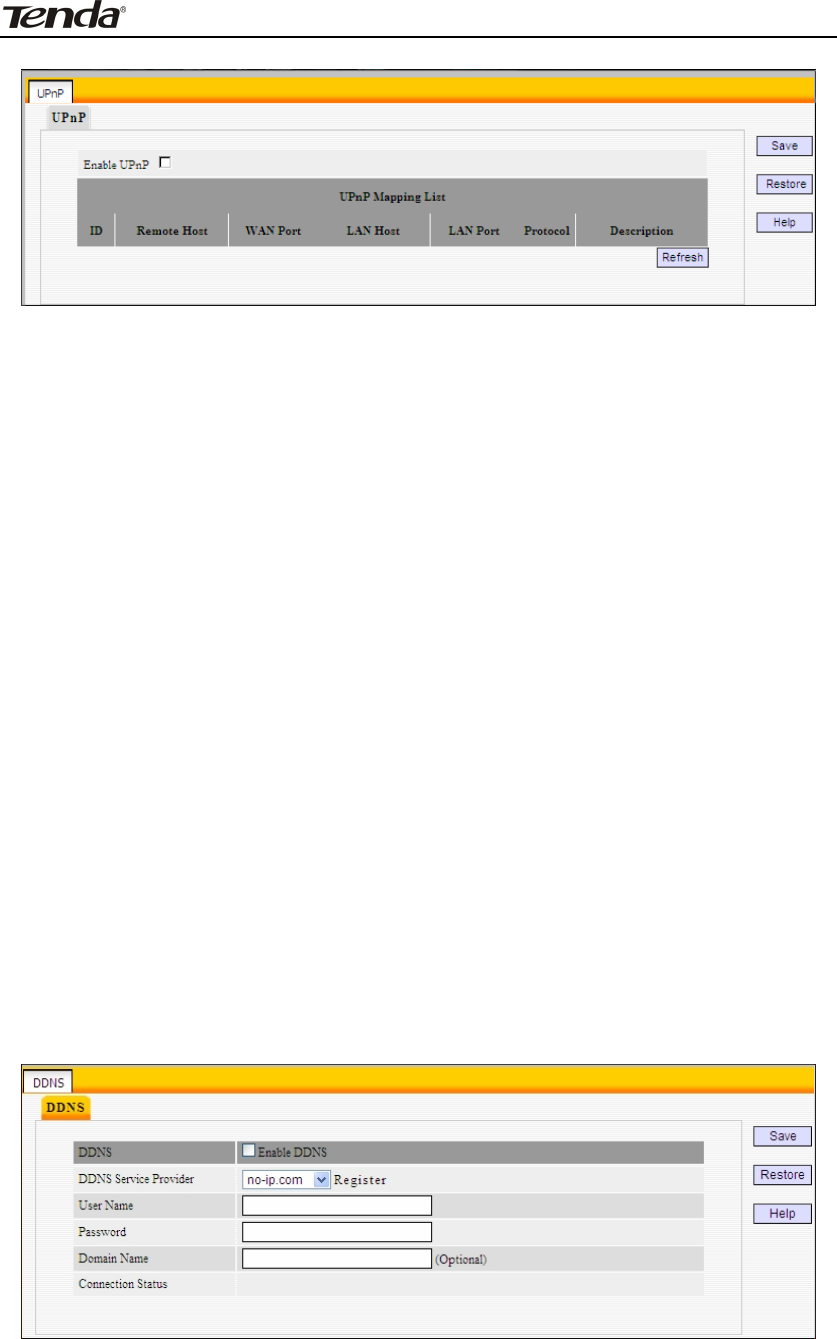
Concurrent Dual Band Wireless N600 Gigabit Router
ID: Entry ID.
Remote Host: Description of a remote host that receives/sends responses.
WAN Port: Port on router side.
LAN Host: Description of an internal host that receives/sends responses.
LAN Port: Port on host side.
Protocol: Indicates whether to perform TCP or UDP port forwarding.
Description: Software info of a mapped port.
4.4.4 DDNS Settings
Dynamic DNS or DDNS is a term used for the updating in real time of Internet
Domain Name System (DNS) name servers. We use a numeric IP address allocated
by Internet Service Provider (ISP) to connect to Internet; the address may either be
stable ("static"), or may change from one session on the Internet to the next
("dynamic"). However, a numeric address is inconvenient to remember; an address
which changes unpredictably makes connection impossible. The DDNS provider
allocates a static hostname to the user; whenever the user is allocated a new IP
address this is communicated to the DDNS provider by software running on a
computer or network device at that address; the provider distributes the
association between the hostname and the address to the Internet's DNS servers so
that they may resolve DNS queries. Thus, uninterrupted access to devices and
services whose numeric IP address may change is maintained.
35
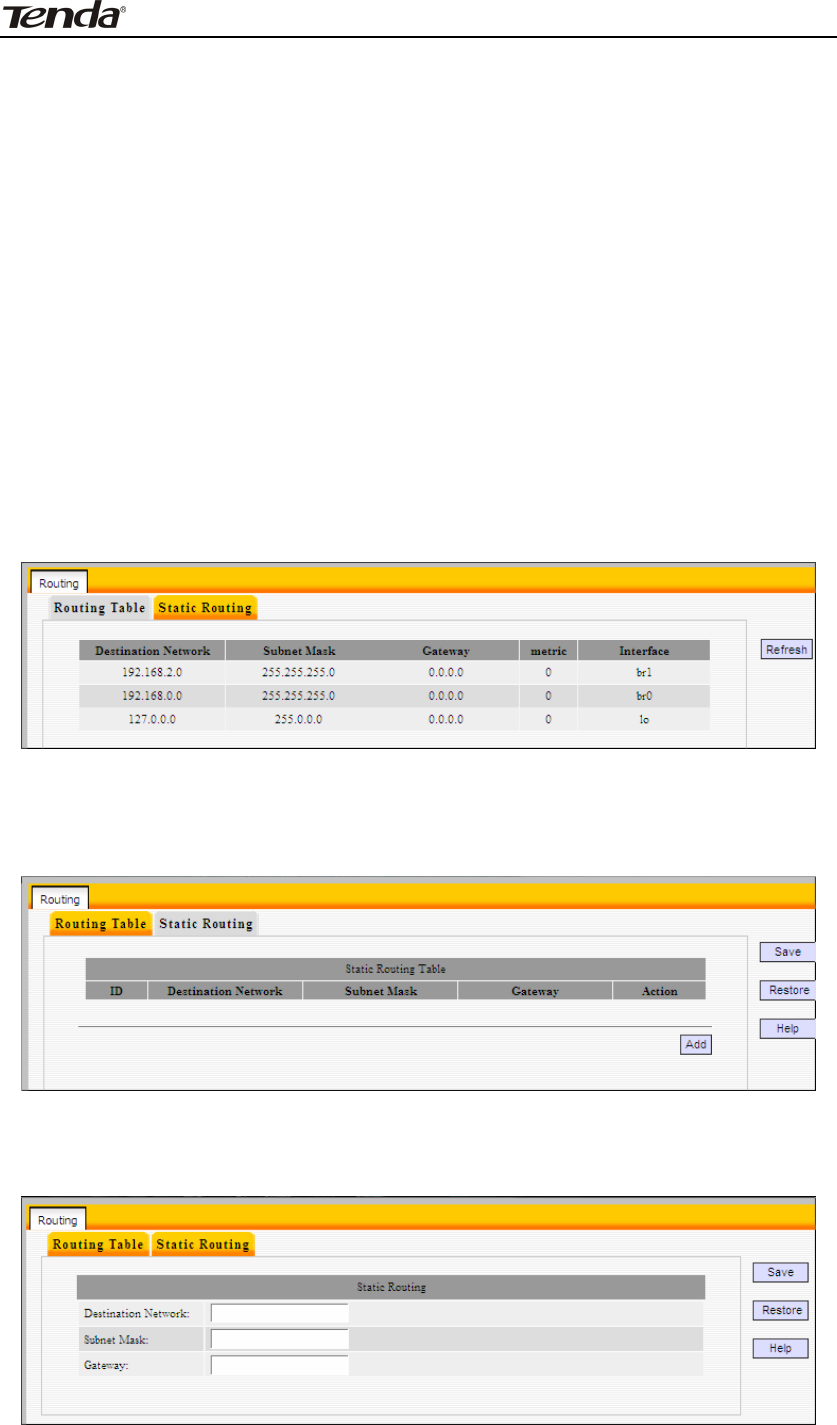
Concurrent Dual Band Wireless N600 Gigabit Router
Enable DDNS: Check the box to Enable or Disable the DDNS feature.
DDNS Service Provider: Select your DDNS service provider from the
drop-down menu (Dyndns or Noip).
Username: Enter the DDNS username registered on DDNS server.
Password: Enter the DDNS password registered on DDNS server.
Domain Name: Enter the DDNS domain name distributed by your DDNS
service provider.
Connection Status: Displays current status connection with the DDNS server.
4.4.5 Routing
This section talks about Routing Table and Static Routing features.
Routing Table
This page displays the router’s core routing table which lists destination IP, subnet
mask, gateway, hop count and interface.
Static Routing
You can use this section to set up router’s static routing feature.
Click “Add” to add static routing entries.
36
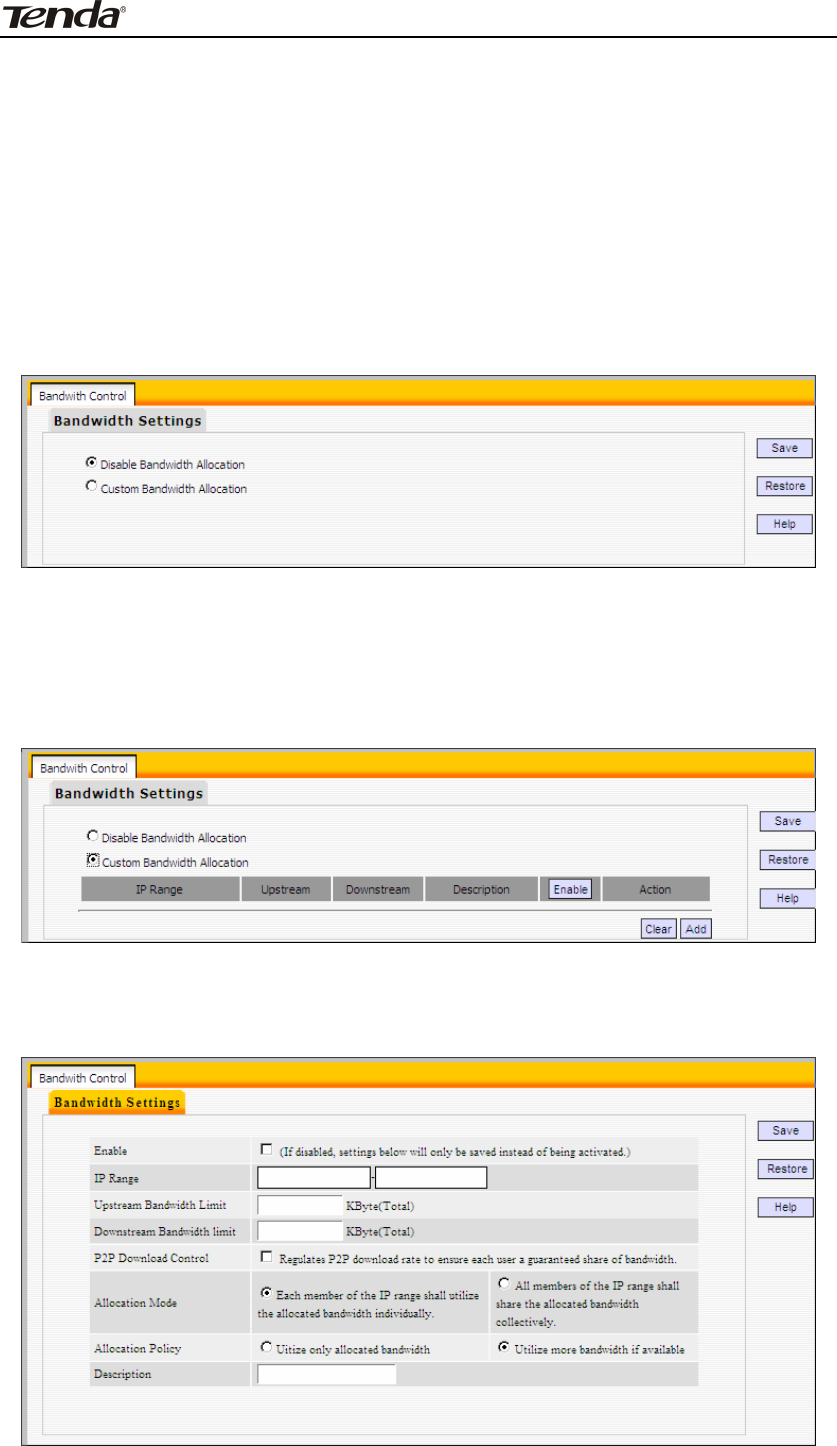
Concurrent Dual Band Wireless N600 Gigabit Router
Destination Network: Enter a destination IP address.
Subnet Mask: Enter a Subnet Mask that corresponds to the destination IP
address you entered.
Gateway: Next-hop IP address.
4.4.6 Bandwidth Control
To better manage bandwidth allocation and optimize network performance, use
the Custom Bandwidth Allocation feature.
Custom Bandwidth Allocation: Select this option to customize a bandwidth
allocation policy that best fits your network. You can set specific limits on
uplink and downlink bandwidth of PCs within a specified IP range.
Click “Add” to display the page below:
37

Concurrent Dual Band Wireless N600 Gigabit Router
Enable: Check/uncheck to enable/disable current bandwidth entry.
IP Range: Enter a single IP or an IP range.
Upstream Bandwidth Limit: Max total upload bandwidth for a specified PC or
a range of PCs.
Downstream Bandwidth Limit: Max total download bandwidth for a specified
PC or a range of PCs.
P2P Download Control: Regulates P2P download rate to ensure each user a
guaranteed share of bandwidth.
Allocation Mode: Select either "Individual (Each member of the IP range shall
utilize the allocated bandwidth individually)" or "Collective (All members of
the IP range shall share the allocated bandwidth collectively)"
Allocation Policy: Select either "Utilize only the allocated bandwidth" or
"Utilize more bandwidth if available".
Description: Brief description of current entry.
Note:
1. Please note the bandwidth unit.
2. If you enable the P2P Download Control feature, it will limit P2P download rate
(smaller than the specified value) to ensure other applications such as web
browsing a reserved and guaranteed share of bandwidth.
3. If you select "Utilize more bandwidth if available", router will dynamically adjust
uplink/downlink bandwidth allocation to ensure defined and additional bandwidth
if available or only defined bandwidth.
For example:
If you want each PC within the IP range of 192.168.0.100-192.168.0.120 to have up
to 2M uplink and 2M downlink bandwidth, and want to control P2P download
bandwidth, then config same settings as shown on the screen below on your
router:
38
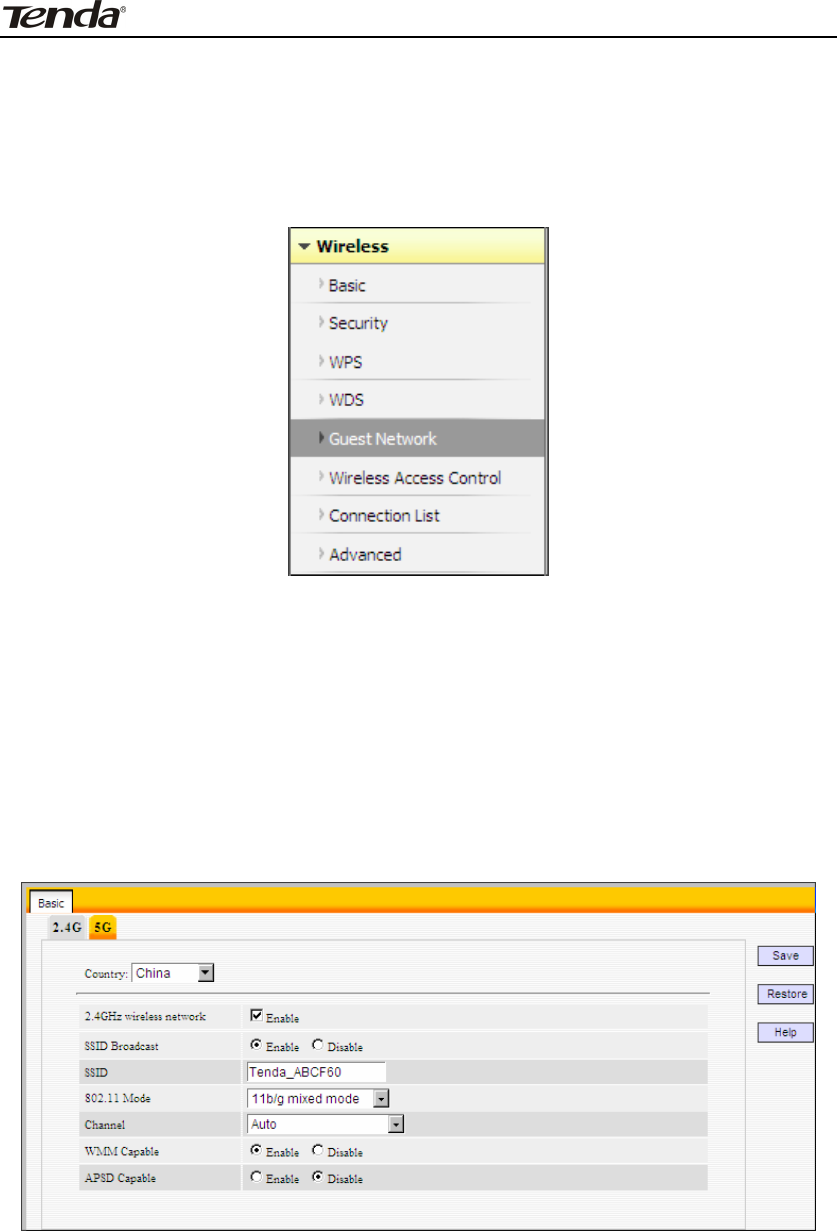
Concurrent Dual Band Wireless N600 Gigabit Router
4.5 Wireless Settings
Wireless Settings includes 8 submenus as shown in the screenshot below. Clicking
any tab enters corresponding interface for configuration.
4.5.1 Basic Settings
This section allows you to manage your wireless network (2.4G or 5G). You can
config country code, wireless network name (SSID), network mode and channel
settings, etc the way you want.
Basic Settings-- 2.4G
Country: Select your country code from the drop-down list. There are 12
options available.
2.4GHz Wireless Network: Check/uncheck to enable/disable the 2.4GHz
wireless feature. If disabled, all 2.4GHz-based features will be disabled
accordingly.
39
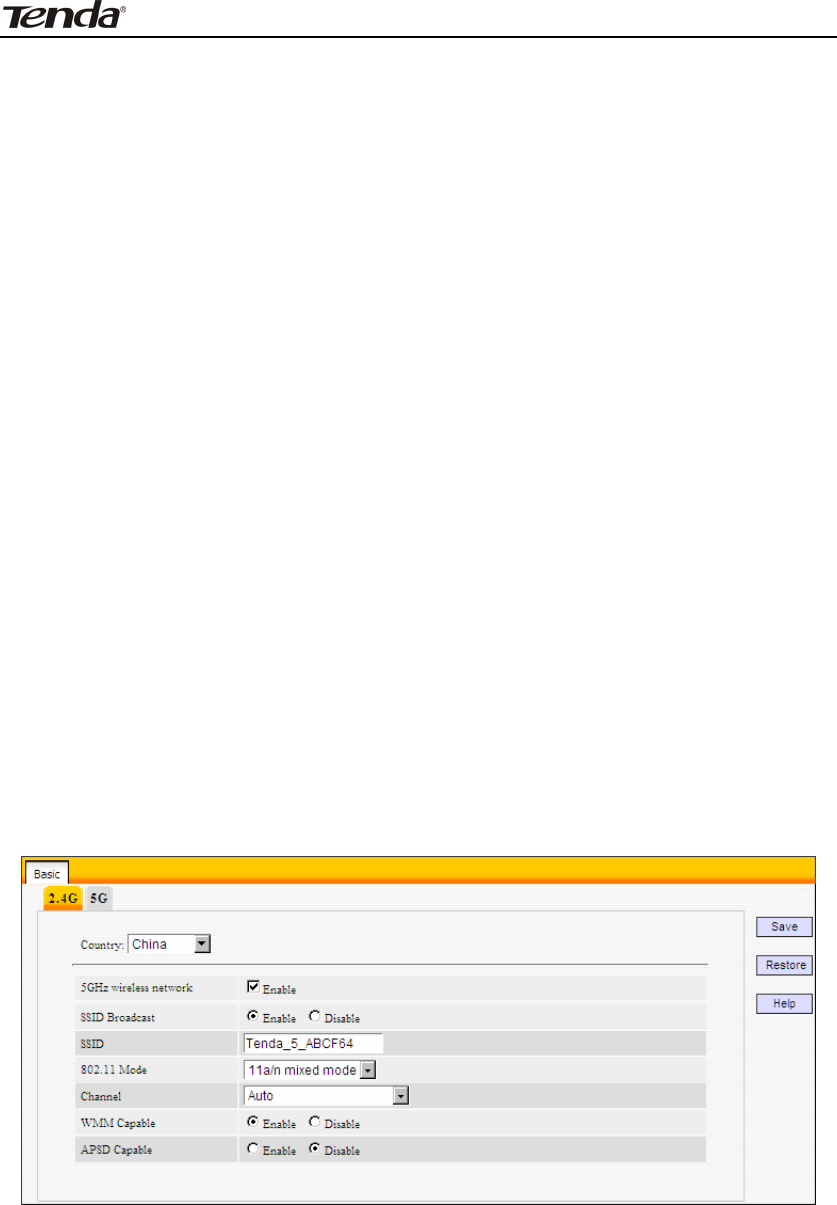
Concurrent Dual Band Wireless N600 Gigabit Router
SSID Broadcast: Select “Enable”/“Disable” to make your wireless network
visible/ invisible to any wireless clients within coverage when they perform a
scan they perform a scan to see what’s available. When disabled, such wireless
clients will have to first know this SSID and manually enter it on their devices if
they want to connect to the SSID. By default, it is enabled.
SSID :A SSID (Service Set Identifier) is the unique name of a wireless network.
802.11 Mode: Select a right mode according to your wireless client. The default
mode is 11b/g/n mixed.
Channel: For an optimal wireless performance, you may select the least
interferential channel. It is advisable that you select an unused channel or
“Auto” to let device detect and select the best possible channel for your
wireless network to operate on from the drop-down list.
Channel Bandwidth: Select a proper channel bandwidth to enhance wireless
performance. When there are 11b/g and 11n wireless clients, please select the
802.11n mode of 20/40M frequency band; when there are only non-11n
wireless clients, select 20M frequency band mode; when the wireless network
mode is 11n mode, please select 20/40 frequency band to boost its
throughput.
Extension Channel:Working network frequency range for 11n mode.
WMM-Capable:Enabling this option may boost transmission capacity of
wireless multimedia data (such as online video play).
ASPD Capable:Select to enable/disable the auto power saving mode.
Basic Settings-- 5G
Country: Select your country code from the drop-down list. There are 12
options available.
5GHz Wireless Network: Check/uncheck to enable/disable the 5GHz wireless
feature. If disabled, all 5GHz-based features will be disabled accordingly.
40
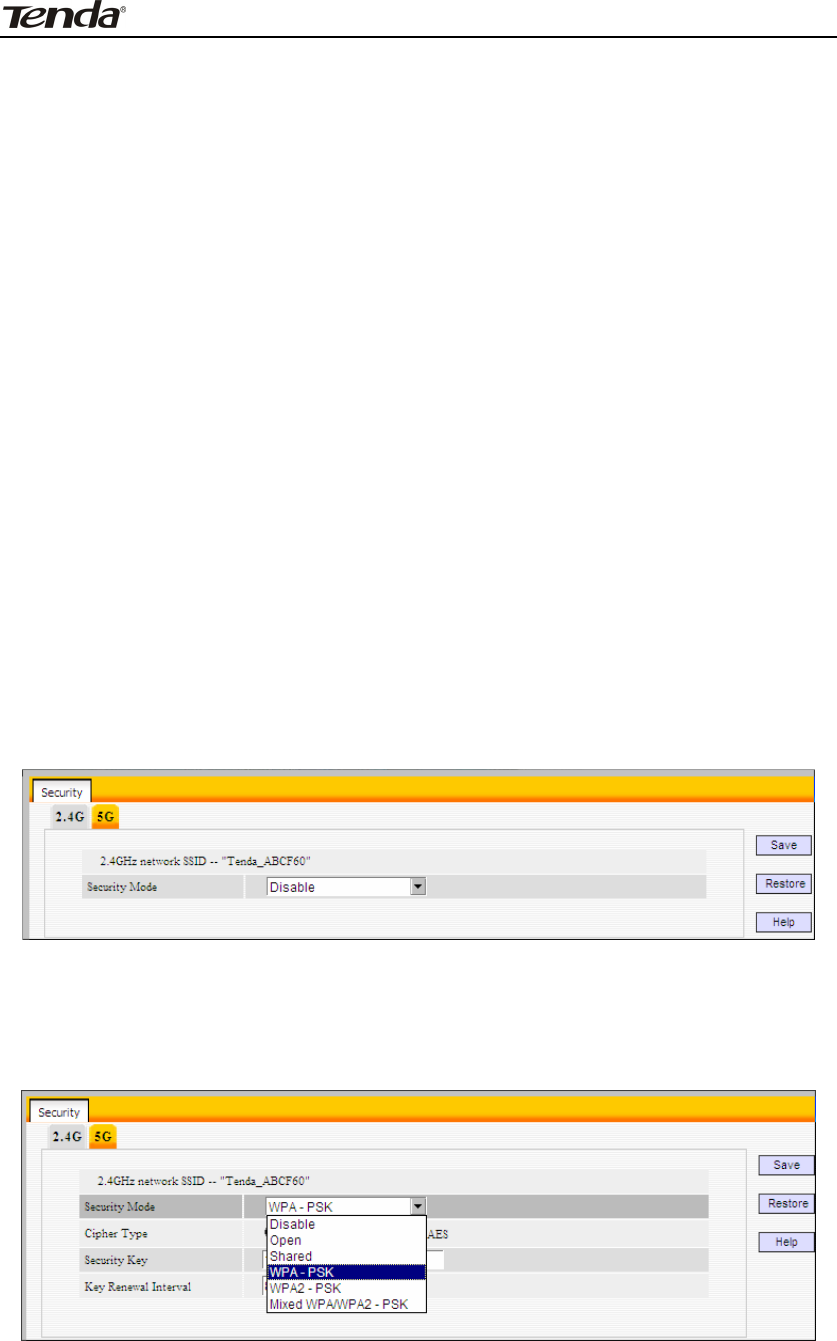
Concurrent Dual Band Wireless N600 Gigabit Router
SSID Broadcast: Select “Disable” to hide your SSID. When disabled, no wireless
clients will be able to see your wireless network when they perform a scan to
see what’s available. If they want to connect to your router, they will have to
first know this SSID and then manually enter it on their devices. By default, this
option is enabled.
SSID: A SSID (Service Set Identifier) is the unique name of a wireless network
(changeable).
802.11 Mode: Select a right mode according to your wireless client. The default
mode is 11a/n.
Channel: The Channel can be changed to fit the channel setting for an existing
wireless network or to customize the wireless network. From the drop-down
list,you can select a most effective channel. You can also select “Auto Select” to
let system detect and choose one that best fits your network.
WMM-Capable: Enabling this option may boost transmission capacity of
wireless multimedia data (such as online video play).
ASPD Capable: Select to enable/disable the auto power saving mode.
4.5.2 Wireless Security
This section allows you to encrypt both 2.4GHz wireless and 5GHz wireless
networks to block unauthorized accesses and malicious packet sniffing.
To config wireless security settings for 2.4GHz network, enter page below:
Available options for security mode include “Open”, “Shared”, “WPA-PSK”,
“WPA2-PSK”, “Mixed WPA/WPA2-PSK”. See below for details.
41
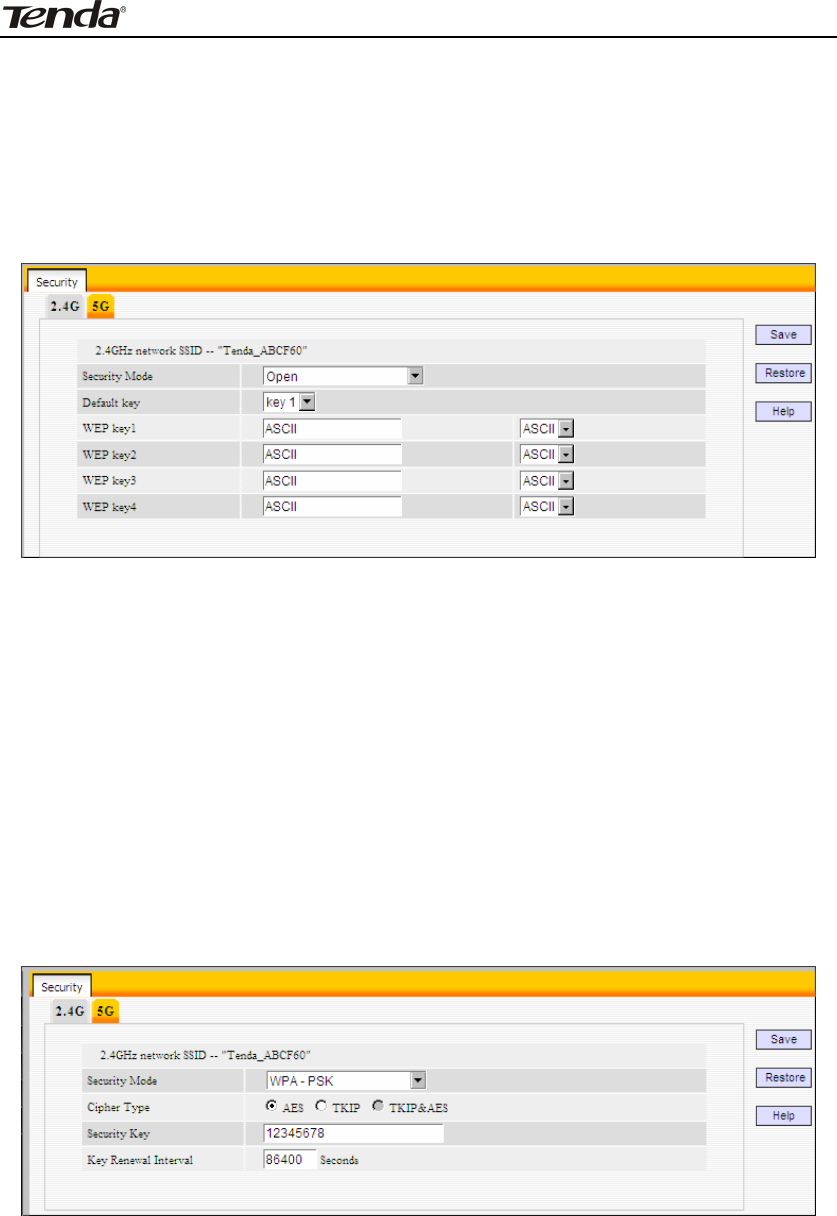
Concurrent Dual Band Wireless N600 Gigabit Router
1. OPEN/SHARED
WEP is intended to provide data confidentiality comparable to that of a traditional
wired network. Two methods of authentication can be used with WEP: Open
System authentication and Shared Key authentication.
Security Mode: Select a proper security mode from the drop-down menu.
Default Key: Select one key from the 4 preset keys to encrypt wireless data on
the network.
2. WPA-PSK
The WPA protocol implements the majority of the IEEE 802.11i standard. It
enhances data encryption through the Temporal Key Integrity Protocol (TKIP)
which is a 128-bit per-packet key, meaning that it dynamically generates a new key
for each packet. WPA also includes a message integrity check feature to prevent
data packets from being hampered with. Only authorized network users can access
the wireless network.
Cipher Type: Select either AES (advanced encryption standard) or TKIP
(temporary key integrity protocol) type.
Security Key: Enter a security key,which must be between 8-63 ASCII
characters.
Key Renewal Interval: Enter a valid time period for the key.
42
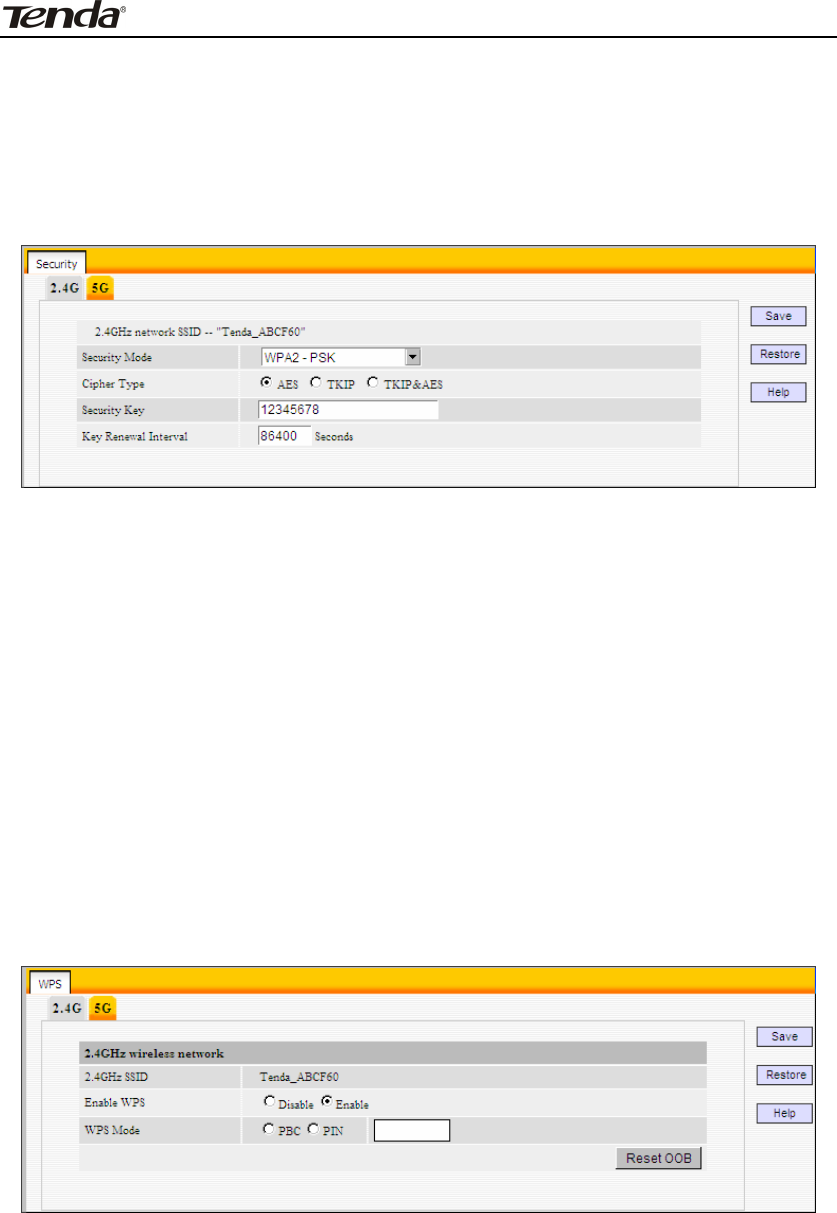
Concurrent Dual Band Wireless N600 Gigabit Router
3. WPA2-PSK
The later WPA2 protocol features compliance with the full IEEE 802.11i standard
and uses Advanced Encryption Standard (AES) in addition to TKIP encryption
protocol to guarantee better security than that provided by WEP or WPA.
Cipher Type: Select one cipher type from AES (advanced encryption standard),
TKIP (temporary key integrity protocol) or TKIP&AES.
Security Key: Enter a security key,which must be between 8-63 ASCII
characters.
Key Renewal Interval: Enter a valid time period for the key.
4.5.3 WPS Settings
Wi-Fi Protected Setup makes it easy for home users who know little of wireless
security to establish a secure wireless home network, as well as to add new devices
to an existing network without entering long passphrases or configuring
complicated settings. Simply enter a PIN code or press the software PBC button or
hardware WPS button (if any) and a secure wireless connection is established.
Enable WPS: Select to enable/disable the WPS encryption.
WPS Mode: Select PBC (Push-Button Configuration) or PIN.
Reset OOB: When clicked, the WPS LED turns off; WPS function will be disabled
automatically; WPS server on the Router enters idle mode and will not respond
to client’s WPS connection request.
43
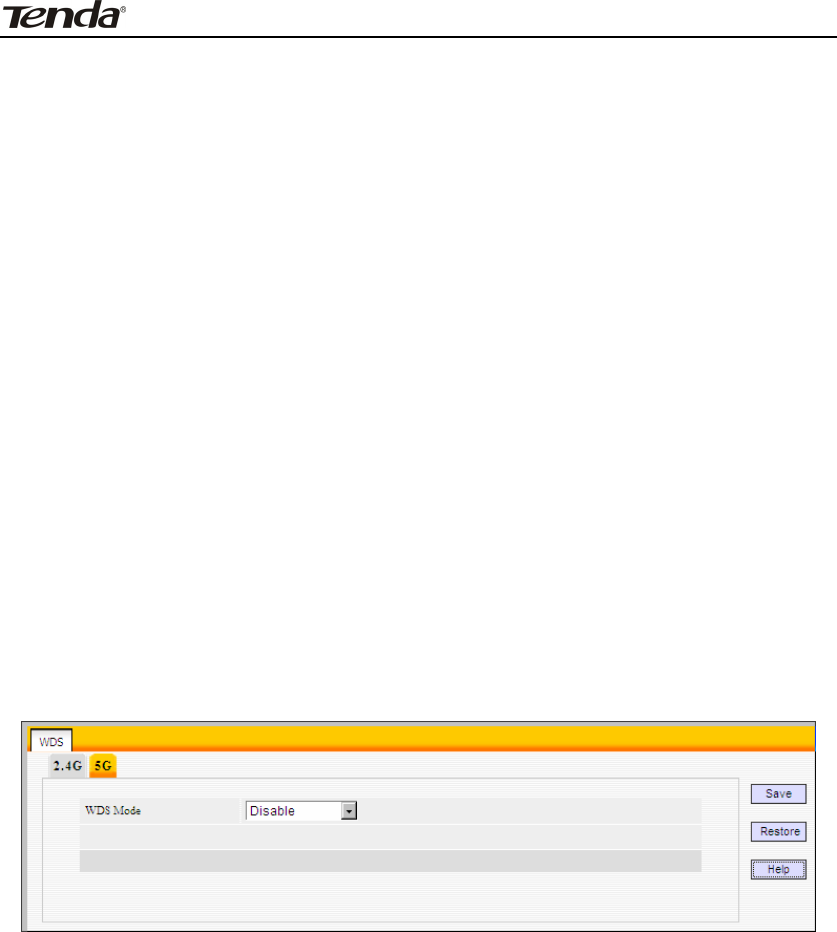
Concurrent Dual Band Wireless N600 Gigabit Router
Operation Instructions
PBC: If you find the WPS LED blinking for 2 minutes after you press the hardware
WPS button on the device, it means that PBC encryption method is successfully
enabled. And an authentication will be performed between your router and the
WPS/PBC-enabled wireless client device during this time; if it succeeds, the wireless
client device connects to your device, and the WPS LED turns off. Repeat steps
mentioned above if you want to connect more wireless client devices to the device.
PIN:To use this option, you must know the PIN code from the wireless client and
enter it in corresponding field on your device while using the same PIN code on
client side for such connection.
Note: The WPS encryption can be implemented only between your Router and
another WPS-capable device.
4.5.4 WDS Settings
WDS (Wireless Distribution System) feature can be used to extend your existing
2.4G or 5G wireless network coverage. Here we present you how to config such
feature in 2.4GHz, which also apply to 5GHz.
Select Repeater Mode to display below page:
AP MAC Address: Enter the MAC address of a wireless link partner or populate
this field using the Open Scan option.
WDS Mode: Select Disable or Repeater Mode.
For example: If you want to implement the WDS feature on 2 N60 routers labeled
N60-1 and N60-2 respectively, then first select “Repeater Mode” and follow steps
below:
44
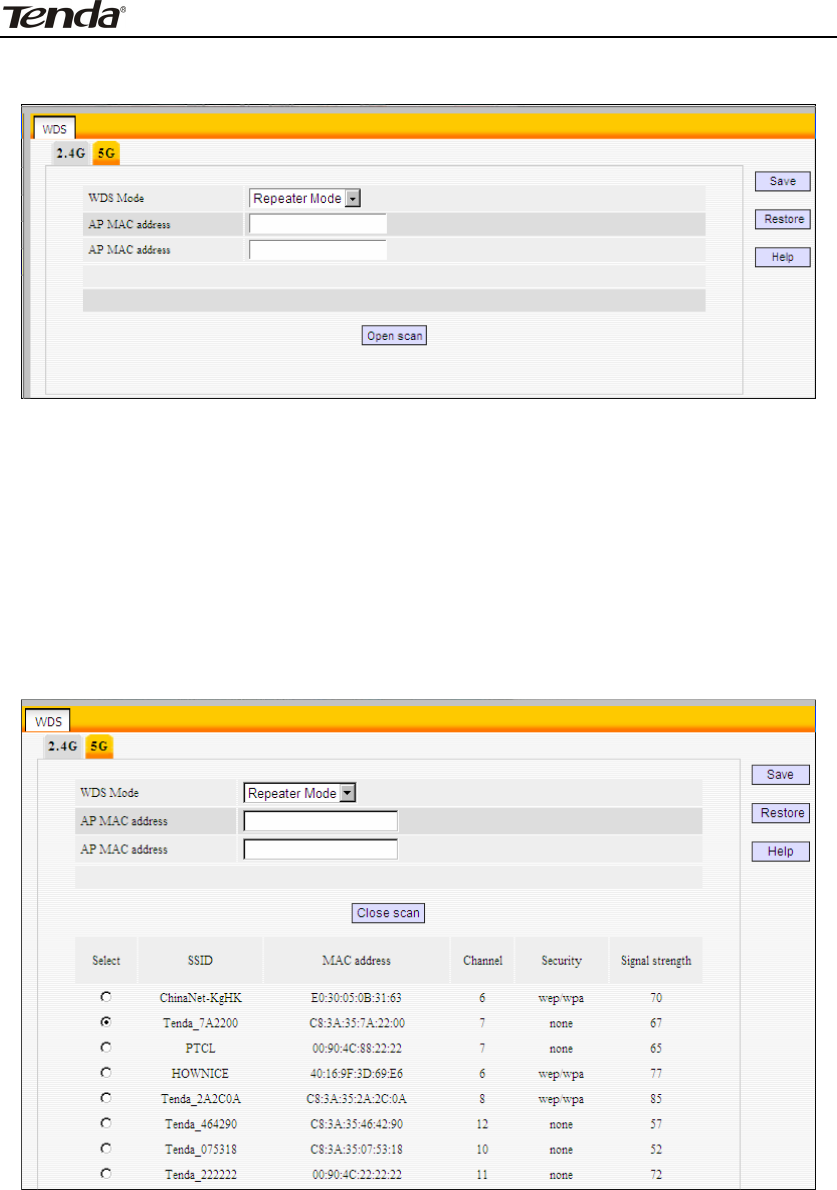
Concurrent Dual Band Wireless N600 Gigabit Router
1. If you already know N60-2’s MAC address, then you can manually enter it on
N60-1 and click “Save”.
2. Or you can use the Open Scan option.
1) Click the “Open Scan” button to search and select N60-2’s SSID, confirm on the
appearing dialogue box and then click “Save”. N60-2’s MAC address will be added
automatically.
2) Save your settings.
45

Concurrent Dual Band Wireless N600 Gigabit Router
3. Repeat steps 1-2 on N60-2. After the 2 devices have added each other’s MAC
address the WDS feature can be implemented.
Note:
1. WDS feature can only be implemented between 2 wireless devices that both
support the WDS feature. Plus, SSID, channel, security settings and security key
must be the same on both such devices.
2. To encrypt your wireless network, see sections 4.5.2-4.5.3. Do remember to
reboot the device after you saved your wireless security settings, otherwise the
WDS feature may not function.
4.5.5 Guest Network
The Guest Network feature allows guests to access Internet and other users on the
guest network while disallowing them to access device web manager, users on
primary network and clients behind the LAN ports. You can find it available in both
2.4G and 5G network. Here we present you how to config such feature in 2.4GHz,
which also apply to 5GHz.
46
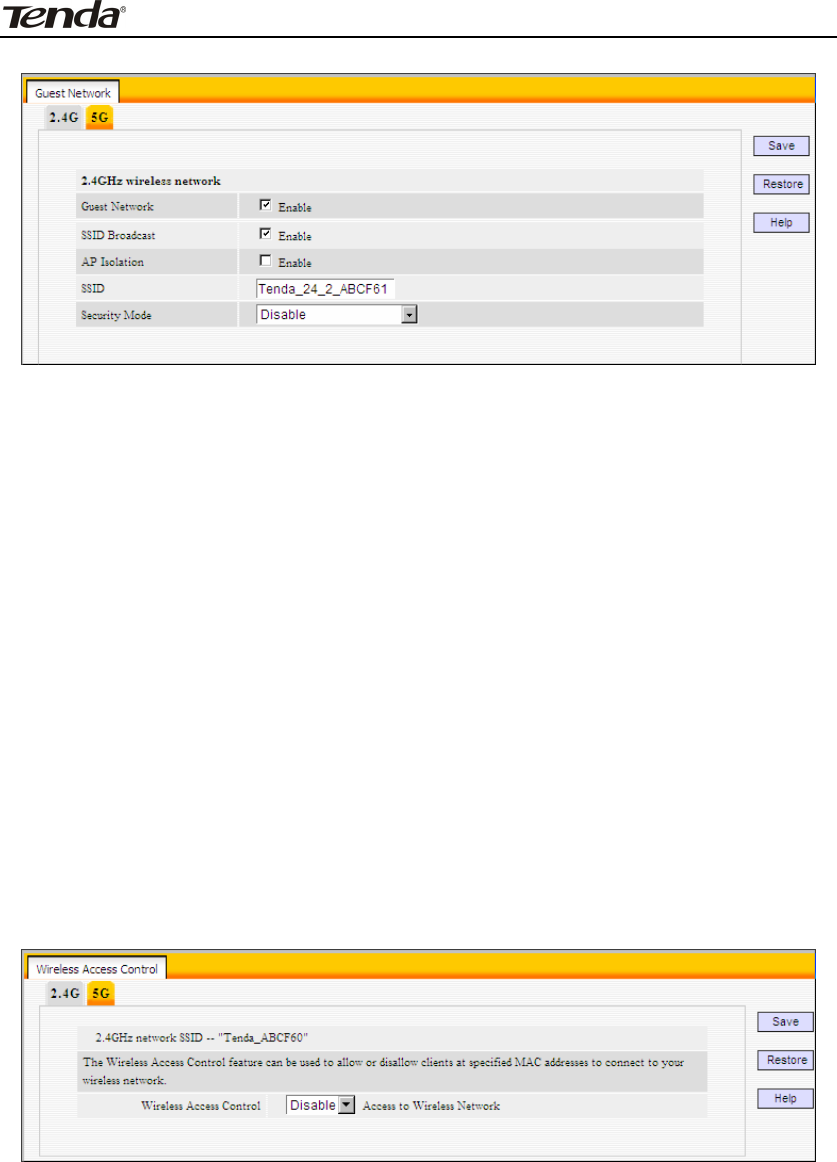
Concurrent Dual Band Wireless N600 Gigabit Router
Guest Network: Check/uncheck to enable/disable the guest network feature.
SSID Broadcast: Select “Disable” to hide your SSID. When disabled, no wireless
clients will be able to see your wireless network when they perform a scan to
see what’s available. If they want to connect to your router, they will have to
first know this SSID and then manually enter it on their devices. By default, it is
enabled.
AP Isolation: If enabled, clients connecting to the guest network will be
mutually inaccessible.
SSID: A SSID (Service Set Identifier) is the unique name of a wireless network.
Security Mode: Determine whether to require authentication on wireless
clients. Select a proper mode from the drop-down menu.
4.5.6 Wireless Access Control
The MAC-based Wireless Access Control feature can be used to allow or disallow
clients to connect to your 2.4G or 5G wireless network. Here we present you how to
config such feature in 2.4GHz, which also apply to 5GHz.
47
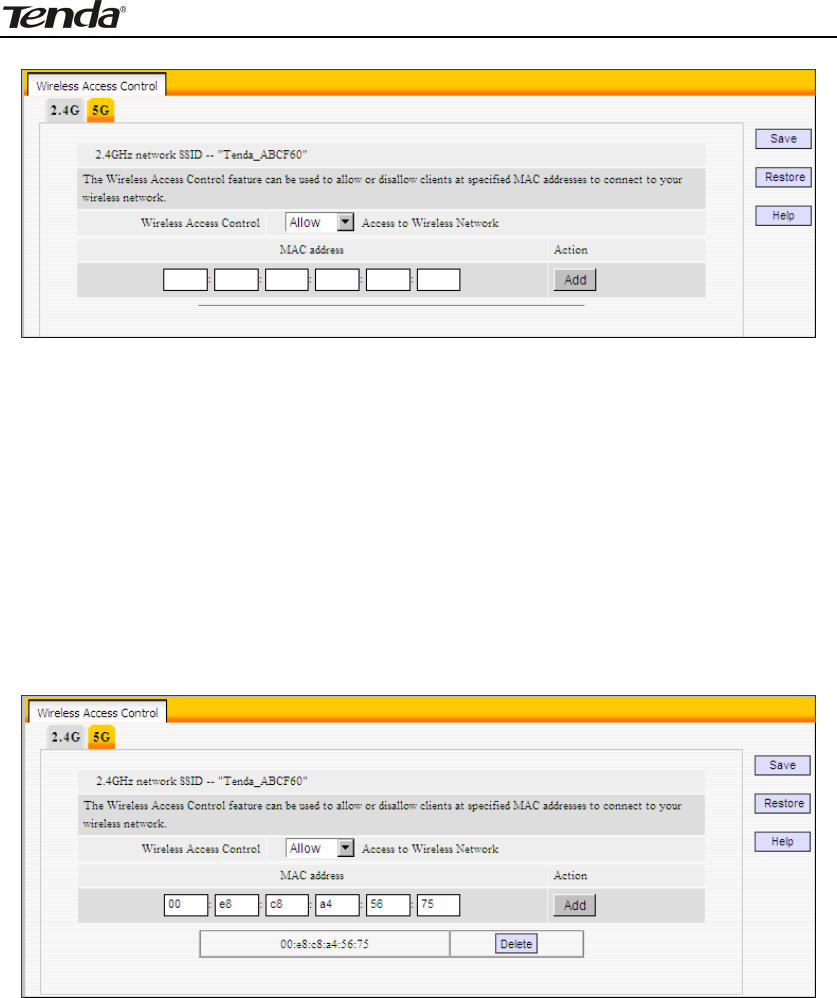
Concurrent Dual Band Wireless N600 Gigabit Router
MAC Address Filter: Selecting “Disable” means to deactivate the MAC address
filter feature. “Allow” means to only allow PCs at specified MAC addresses to
connect to your wireless network while “Deny” means to only block PCs at
specified MAC addresses from connecting to your wireless network.
MAC Address:Enter the MAC addresses of a wireless client.
Add: Click it to add a new MAC to the MAC address list.
Delete: Click it to remove an existing entry.
To allow only a PC at the MAC address of 00:e8:c8:a4:56:75 to connect to your
wireless network, do as follows:
Step1. Select “Allow” from MAC Address Filter drop-down menu.
Step2. Enter 00:e8:c8:a4:56:75 in the MAC address box and click “Add”.
Step3. Click the “OK” button to save your settings and you can add more MAC
addresses, if you like, simply repeating the above steps.
4.5.7 Connection Status
This interface displays the information of currently connected 2.4G and 5G wireless
clients (if any).
48

Concurrent Dual Band Wireless N600 Gigabit Router
4.5.8 Wireless –Advance Settings
This section allows you to config advanced settings, including Beacon interval,
Fragment threshold,RTS threshold and DTIM interval, etc, for both 2.4G and 5G
wireless networks.
AP Isolation: Isolates clients connecting to the private SSID.
Beacon Interval: A time interval between any 2 consecutive Beacon packets sent
by device. Do NOT change the default value of 100 unless necessary.
Fragment Threshold: Enter a Fragment Threshold (256-2346). Any wireless
packet exceeding such set value will be divided into several fragments. DO NOT
change the default value of 2346 unless necessary.
RTS Threshold: If a packet exceeds such set value, RTS/CTS scheme will be
used to reduce collisions. Set it to a smaller value provided that there are distant
clients and interference. For normal SOHO, it is recommended to keep the default
value unchanged; otherwise, device performance may be degraded.
DTIM Interval: A time interval between any two consecutive broadcast and multicast
packet messages sent by the device to clients. When such packets arrive at device’s
buffer, the device will send DTIM (delivery traffic indication message) and DTIM
interval to wake clients up for receiving these packets.
49
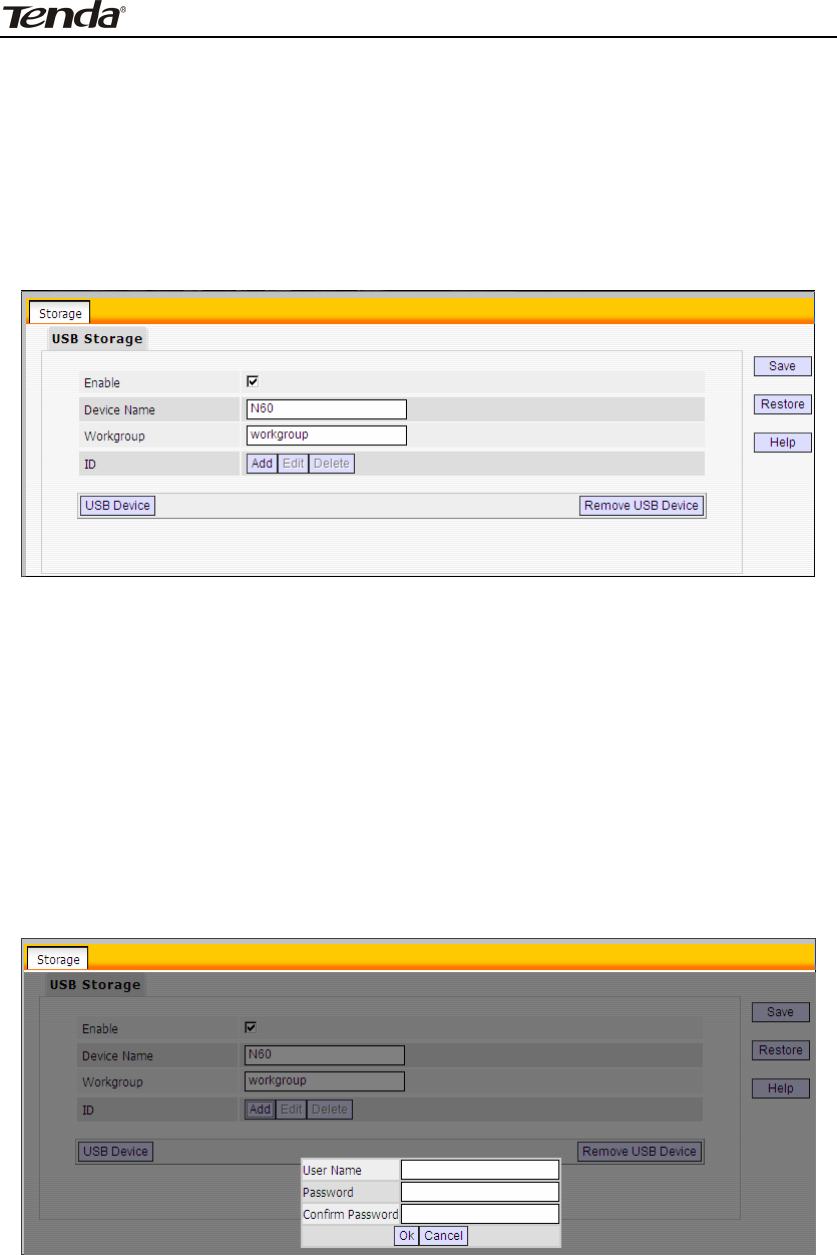
Concurrent Dual Band Wireless N600 Gigabit Router
4.6 USB Applications
The router provides a USB interface, which can be connected to a printer or USB
storage device for file sharing.
4.6.1 USB Storage
Enable: Check/uncheck to enable/disable file sharing feature.
Device Name: Define a meaningful name to you for the device.
Work Group: Define a work group name for the device.
Add: Click to add an account. Up to 5 accounts can be added.
Edit: Click to edit an existing account.
Delete: Click to delete an existing account.
Operation Instructions:
1. Create an account.
1). Click “Add” to display a dialogue box below:
2) Enter a user name and a password, which will be used by clients when accessing
the USB storage device for sharing files thereon.
3) Re-type to confirm password and then click the “OK” button.
50
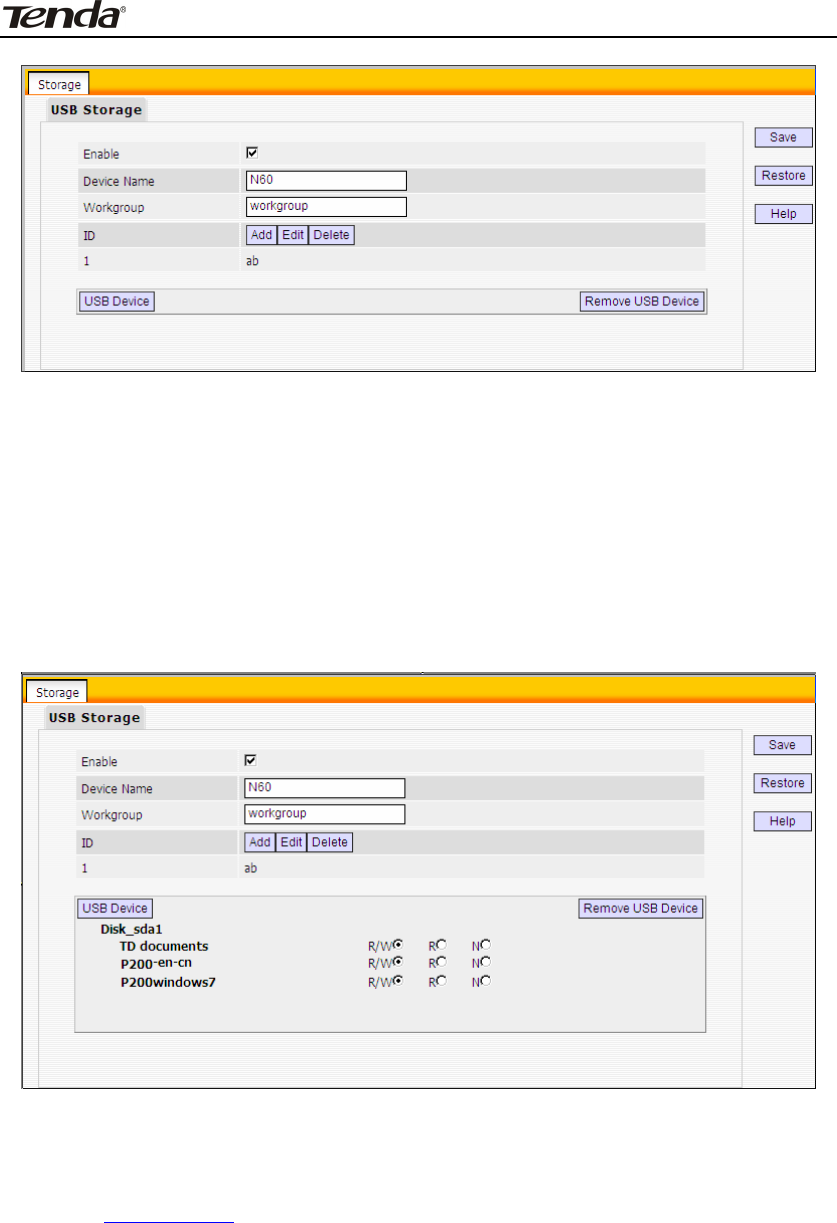
Concurrent Dual Band Wireless N600 Gigabit Router
2. Set Access Right
First select an account and click Disk. And then select a proper access right from
below for each entry.
R/W:Read and Write right.
R: Read right.
N: No right.
At last click “Save” to apply your settings.
3. Access shared file
To access resources on such storage device, double click “My Computer” on your PC
and enter \\192.168.0.1.
51
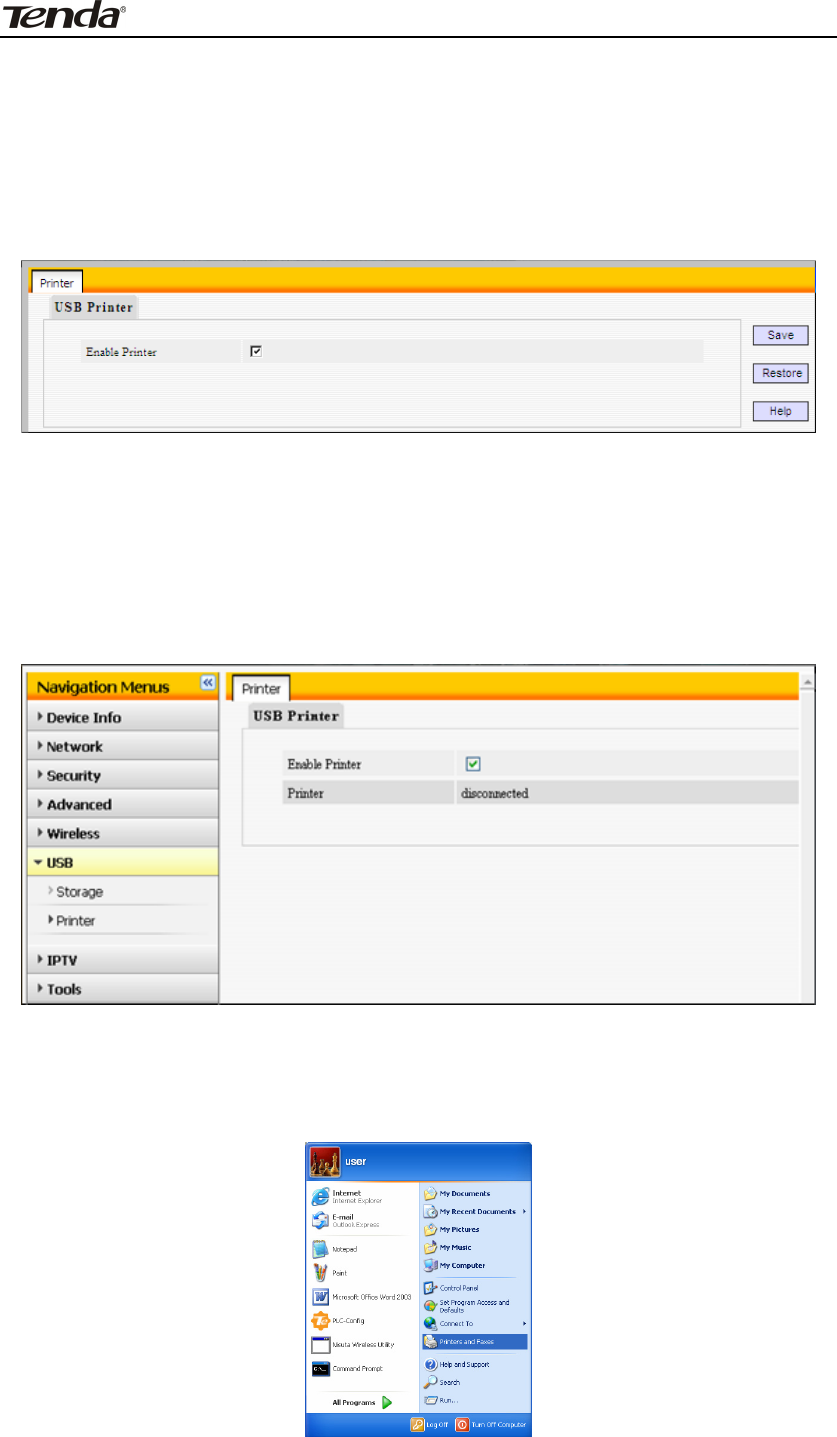
Concurrent Dual Band Wireless N600 Gigabit Router
4.6.2 Printing Service
The USB printer service allows you to connect a USB printer to the device and thus
all clients on your network can print anything they want on their PCs. The device
can identify a printer automatically as long as it is successfully connected.
Enable Printer: Check/uncheck to enable/disable USB printer service.
Operation Instructions
1. Correctly connect your USB printer to the USB port on the device.
2. Enable printer service.
3. On your PC (connected to the device), click “Start”——“Settings”——“Printers
and Faxes” and select “Add a printer” on appearing window.
52
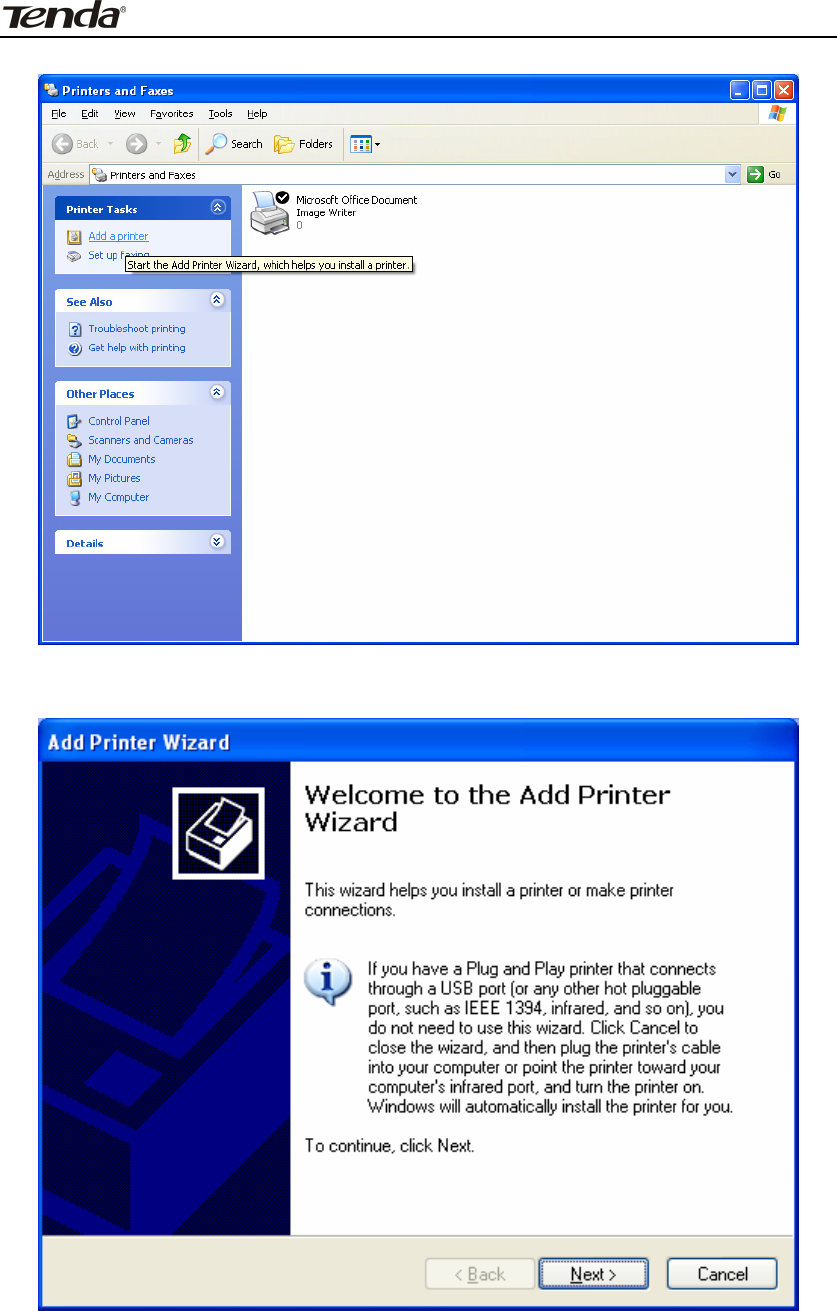
Concurrent Dual Band Wireless N600 Gigabit Router
4. Click “Next”.
5. Select “Local printer attached to this computer” and click “”Next.
53

Concurrent Dual Band Wireless N600 Gigabit Router
6. Select “Create a new port”, Type of port: “Standard TCP/IP Port” and click “Next”.
7. Click “Next”.
54

Concurrent Dual Band Wireless N600 Gigabit Router
8. Enter device’s LAN IP address and click “Next”.
9. Click “Standard” under Device Type and select “Generic Network Card”, then click
“Next”.
55

Concurrent Dual Band Wireless N600 Gigabit Router
10. Click “Finish”.
11. Select “Have Disk”.
56
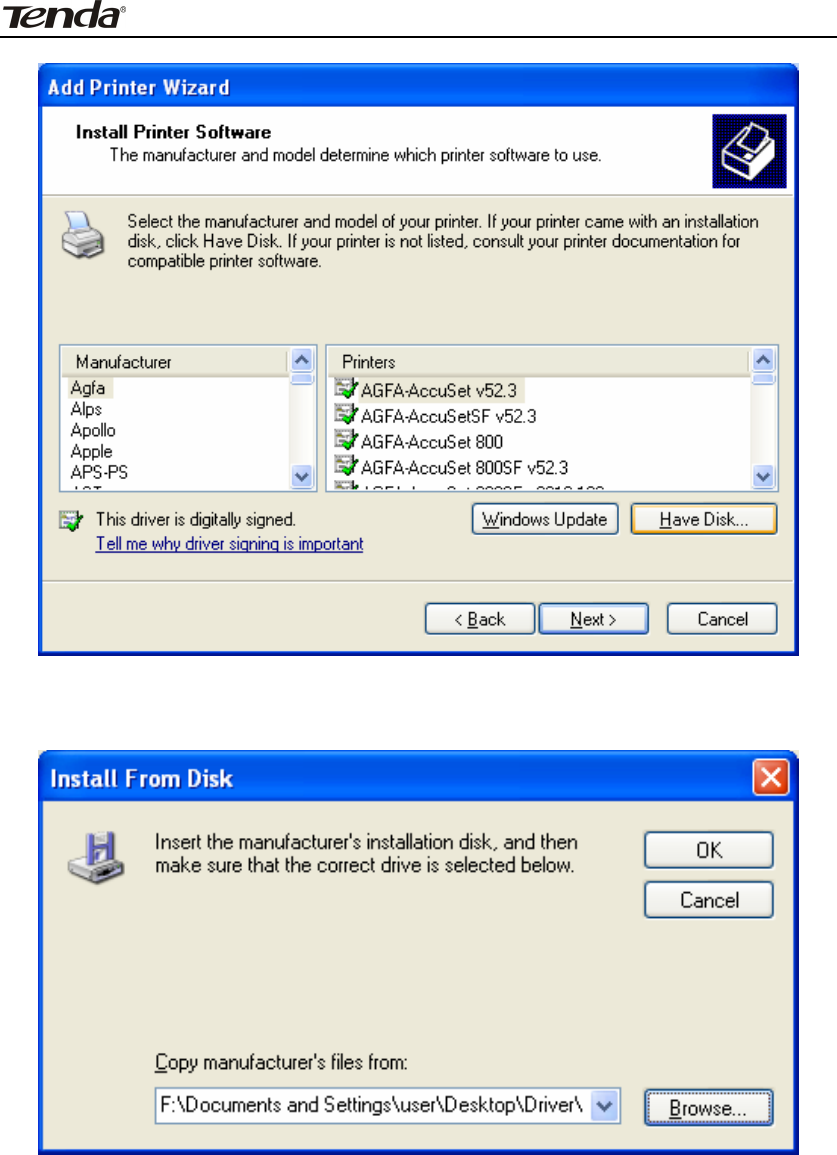
Concurrent Dual Band Wireless N600 Gigabit Router
12. Click “Browse”, select corresponding drive file and click “Open”. At last click “OK”.
13. Click “Next”.
57
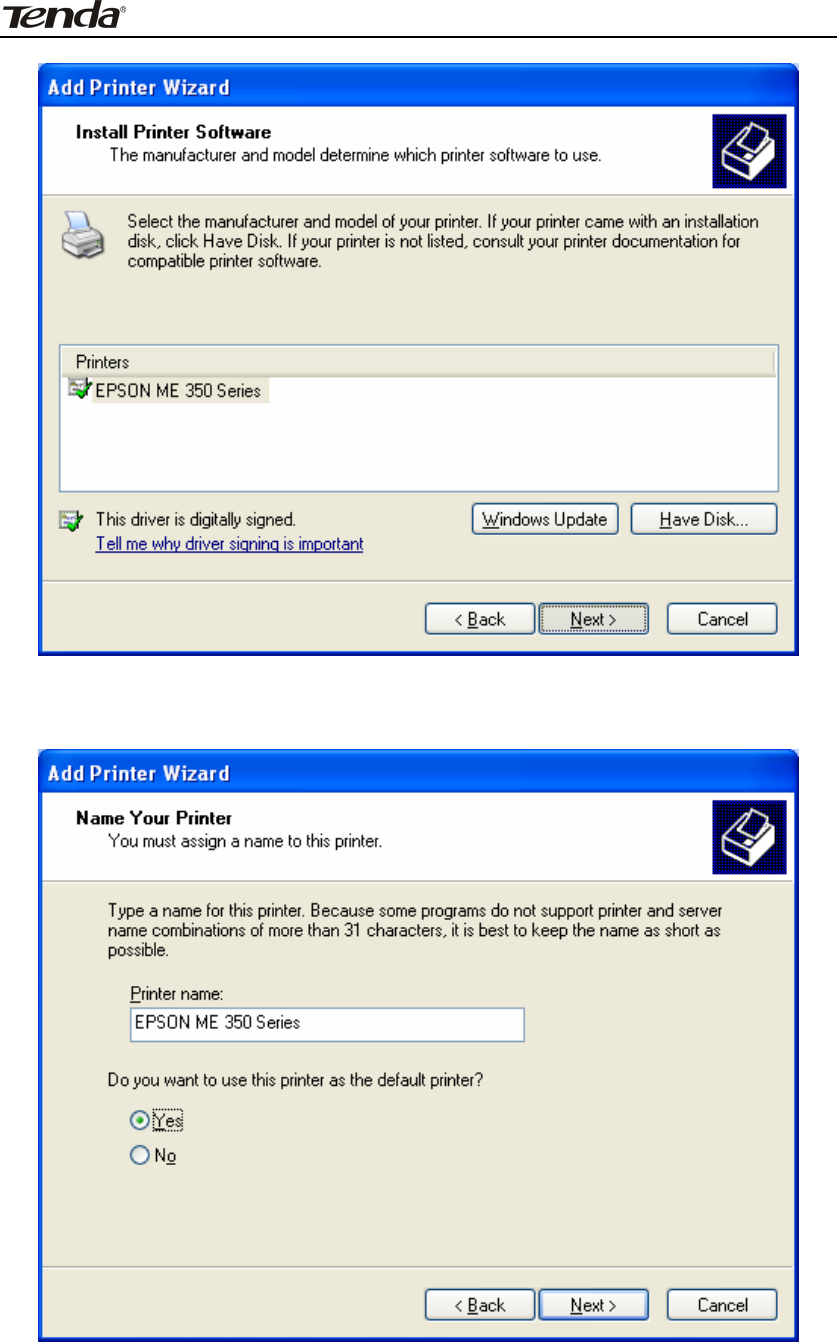
Concurrent Dual Band Wireless N600 Gigabit Router
14. Define a name for the printer and click “Next”.
15. Click “Finish".
58
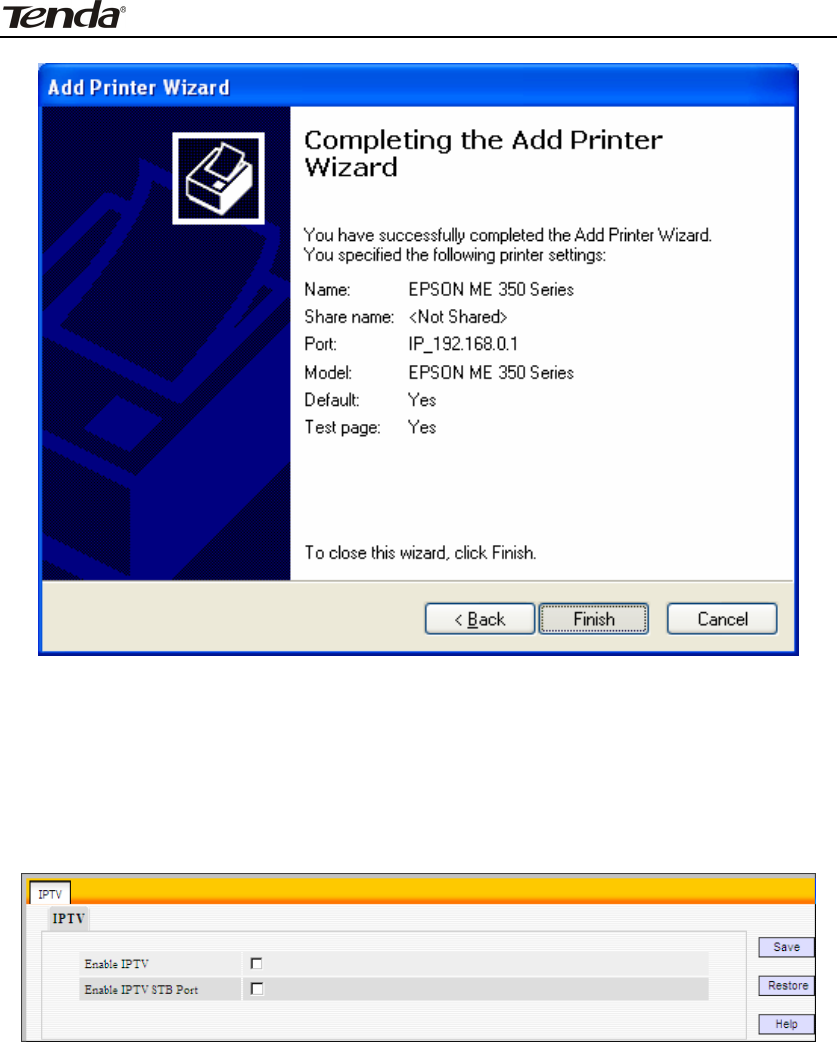
Concurrent Dual Band Wireless N600 Gigabit Router
4.7 IPTV Settings
The IPTV feature makes it possible to enjoy online videos on your TV set via a
set-top box while surfing Internet.
Enable IPTV: Check/uncheck to enable/disable the IPTV feature.
Enable IPTV STB Port: Check/uncheck to enable/disable the IPTV-specific port.
See below for the topology:
59
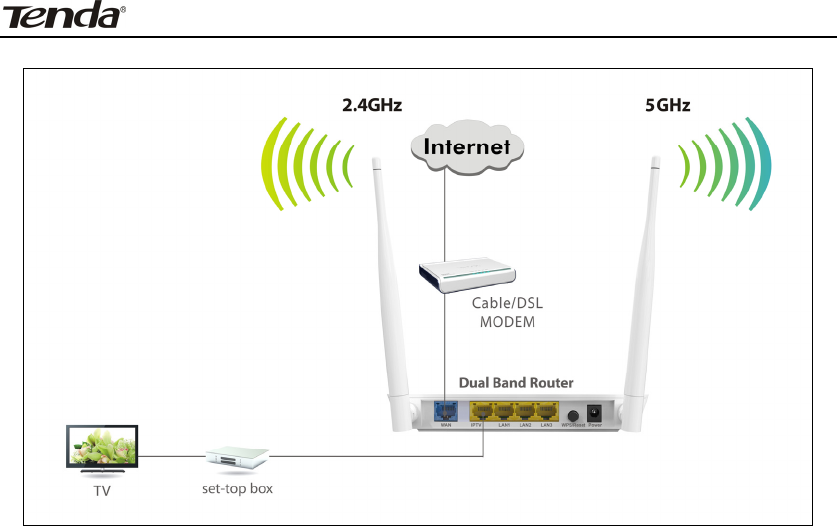
Concurrent Dual Band Wireless N600 Gigabit Router
Note:
1. If you enabled both options mentioned above, then note below:
(a). Set IPTV connection type to DHCP/dynamic IP or static IP (IMPORTANT: Note
that the IP address should be on the same IP net segment as router’s WAN IP.) if the
set-top box is connected to any LAN port from 1-3.
(b). Select the dial mode provided by your ISP if the set-top box is connected to the
IPTV-specific port.
2. After the IPTV port is set for IPTV purpose, PC that connects to such port will not
be able to obtain an IP address or access Internet. So think twice before you start.
Plus, LAN ports1-3 can only be used to connect PCs instead of an IPTV set-top box.
3. The IPTV feature does not support wireless access.
4.8 Tools
System tools include the following 8 submenus. Clicking any of them enters
corresponding interface for configuration. Below explains, in details, each such
feature.
60

Concurrent Dual Band Wireless N600 Gigabit Router
4.8.1 Time Settings
This section assists you in setting the device’s system time; you can either select to
set the time and date manually or automatically obtain the GMT time from Internet.
Sync with Internet time servers: Time and date will be updated
automatically from Internet.
Sync Interval: Determines a time length when device periodically updates
its time and date info from Internet. The default is 2 hours.
Time Zone: Select your current time zone.
Copy Local Time: Click it to copy your PC’s time to the device.
4.8.2 Firmware Upgrade
Firmware upgrade is released periodically to improve the functionality of your
device and also to add new features. If you run into a problem with a specific
feature of the device, log on to our website www.tendacn.com to download the
latest firmware to update your device.
61
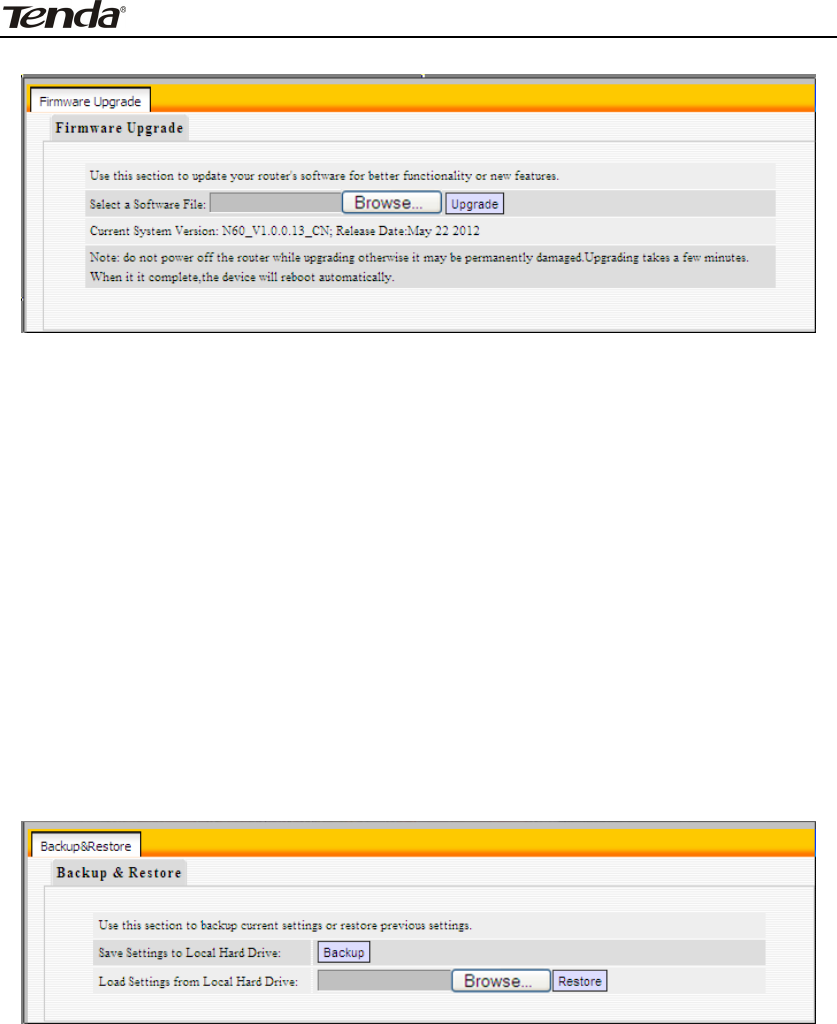
Concurrent Dual Band Wireless N600 Gigabit Router
To update firmware, do as follows:
1. Click "Browse” to locate the firmware and "Upgrade” to update.
2. Router will reboot automatically when upgrade completes.
NOTE: Do not disconnect the device from your management PC (the PC you use to
configure the device) or power off it during the upgrade process; otherwise, it may
be permanently damaged. The device will restart automatically when the upgrade
process, which takes several minutes, completes.
4.8.3 Backup/Restore Settings
This section allows you to backup current settings or to restore the previous
settings configured on the device.
Backup Settings: Once you have configured the device the way you want it,
you can save these settings to a configuration file on your local hard drive that
can later be imported to your device in case that the device is restored to
factory default settings. To do this, click the “Backup” button and specify a
directory to save settings on your local hardware.
Restore Settings: Click the "Browse" button to locate and select a
configuration file that is saved previously to your local hard drive. And then
click the "Restore" button to reset your device to previous settings.
62
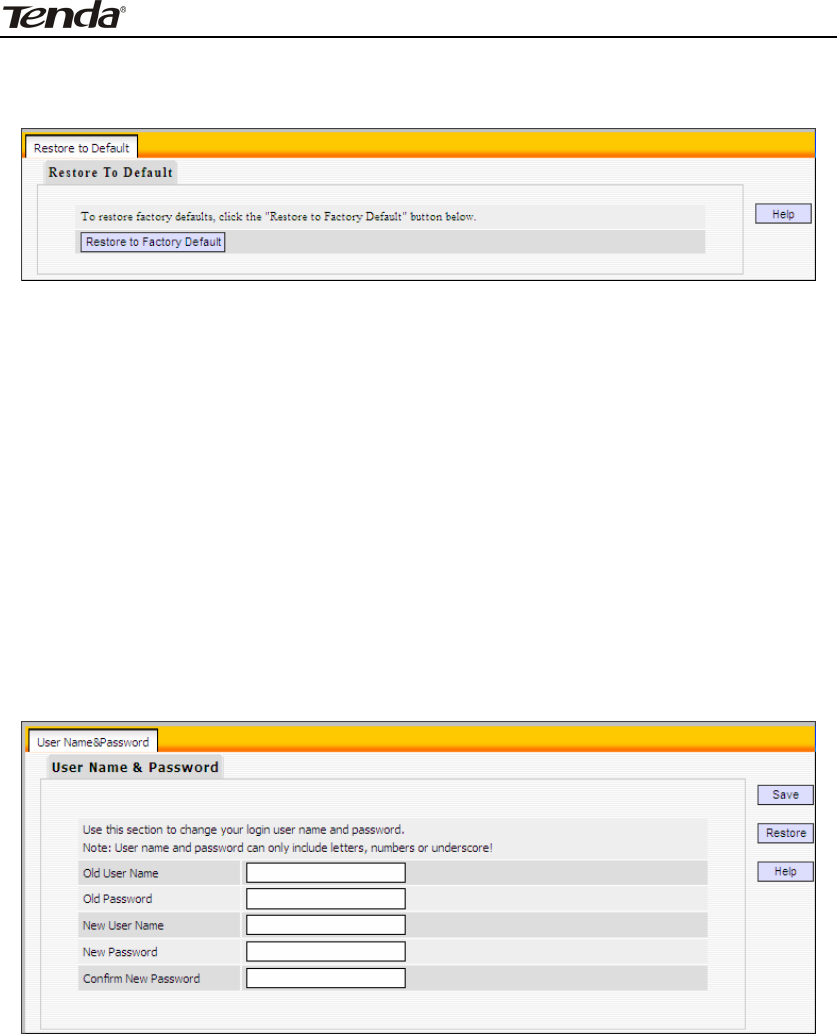
Concurrent Dual Band Wireless N600 Gigabit Router
4.8.4 Restore to Factory Default Settings
To restore all settings to the device's factory default values, click the "Restore to
Factory Default” button:
Factory Default Settings:
User Name: admin
Password: admin
IP Address: 192.168.0.1
Subnet Mask: 255.255.255.0
Note: To activate your settings, you need to reboot the device after you reset it.
4.8.5 Change Password/User Name
This section allows you to change login password and user name for accessing
device’s Web-based interface.
¾ Old Password/User Name: Enter the old password/user name.
¾ New Password/User Name: Enter a new password/user name.
¾ Confirm New Password: Re-enter the new password for confirmation.
¾ Save: Click it to save new settings.
NOTE: For the sake of security, it is highly recommended that you change default
login password and user name.
63
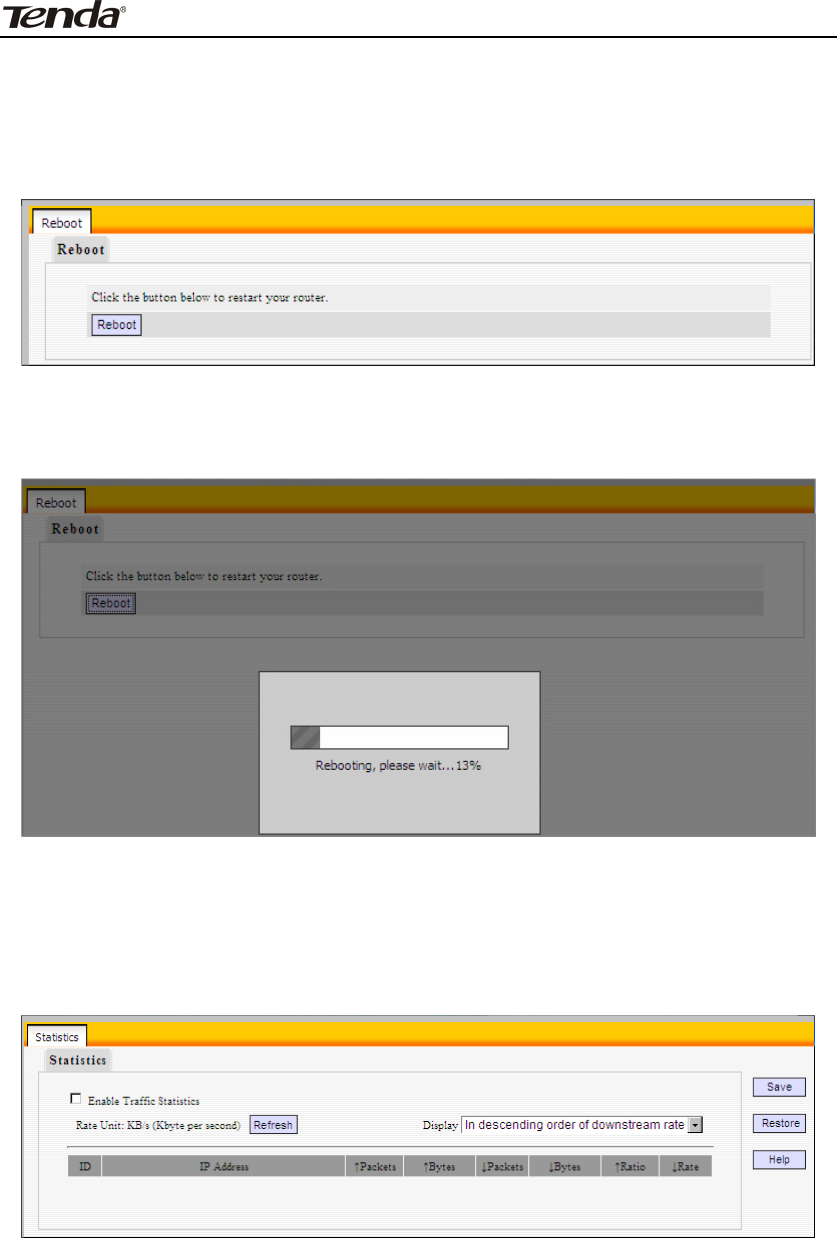
Concurrent Dual Band Wireless N600 Gigabit Router
4.8.6 Reboot
This section allows you to reboot the device.
To restart your device, click the “Reboot” button.
4.8.7 Statistics
Statistics displays current traffic of PCs on your LAN.
Enable Traffic Statistics: Check/uncheck the box to enable/disable the Traffic
Statistics feature.
Refresh: Click to update statistic data.
Clear: Click to remove statistic data.
64
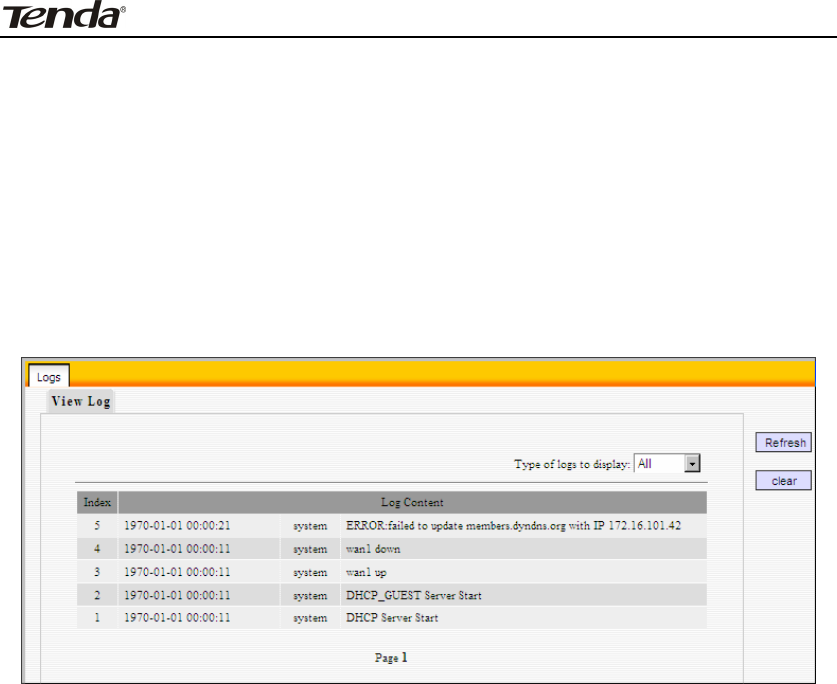
Concurrent Dual Band Wireless N600 Gigabit Router
Note: Enabling the Traffic Statistics feature may degrade router’s packet processing
capacity. So, do not enable it unless necessary.
4.8.8 Syslog
The Syslog option allows you to view all events that occur upon system startup
and check whether there is attack present in your network.
The logs are classified into 3 types: “All”, “System “and “WAN”.
65
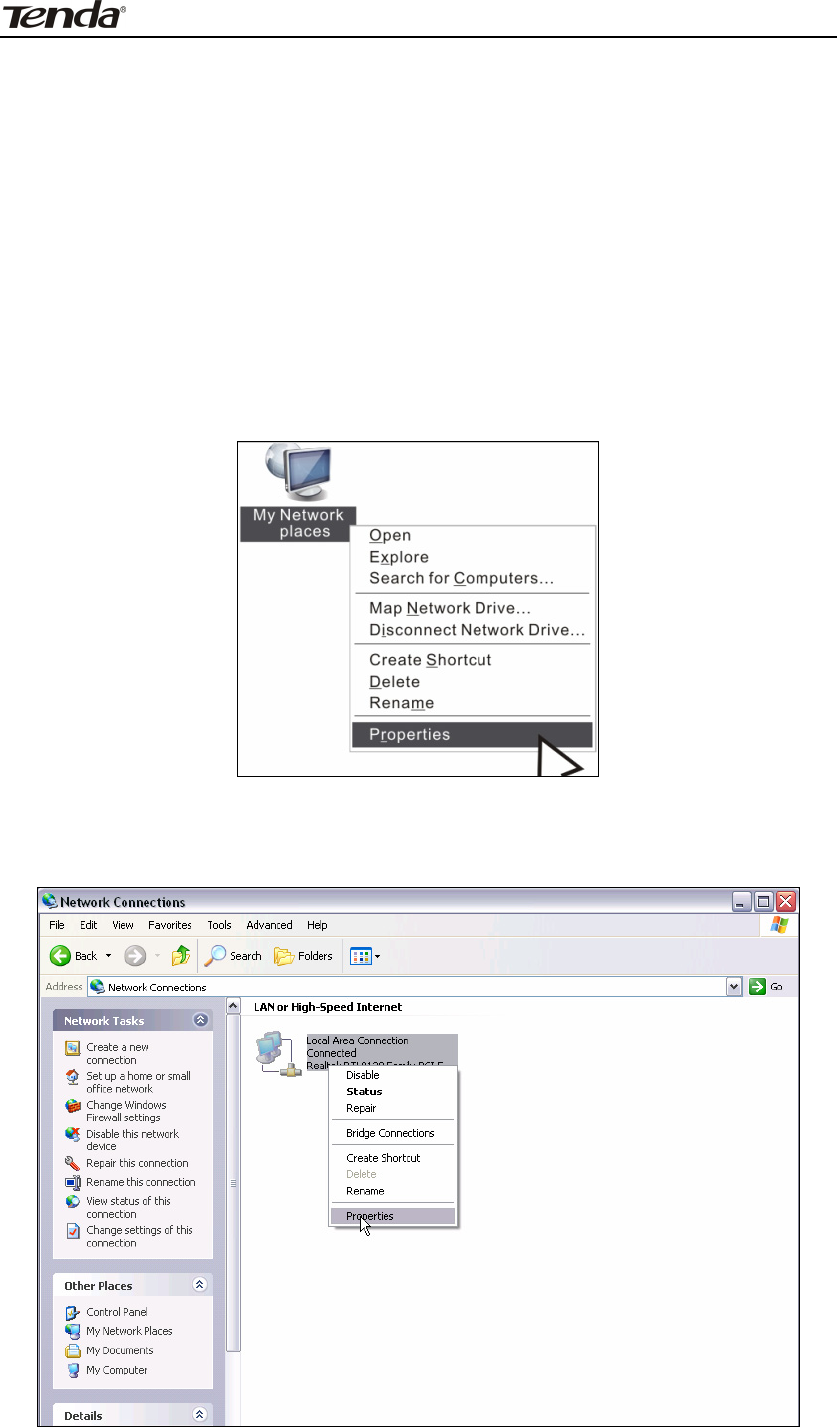
Concurrent Dual Band Wireless N600 Gigabit Router
A ppendix 1 Config TCP/IP Settings on PC
This section presents you how to config your PC’s TCP/IP settings (in Windows XP
and Windows 7). Before you start, make sure your PC has an installed NIC. If not,
please install one first.
Windows XP
If you are using Windows XP operating system, do as follows:
1. Right click “My Network Places” and select “Properties”.
2. Right click “Local Area Connection” and select “Properties”
66
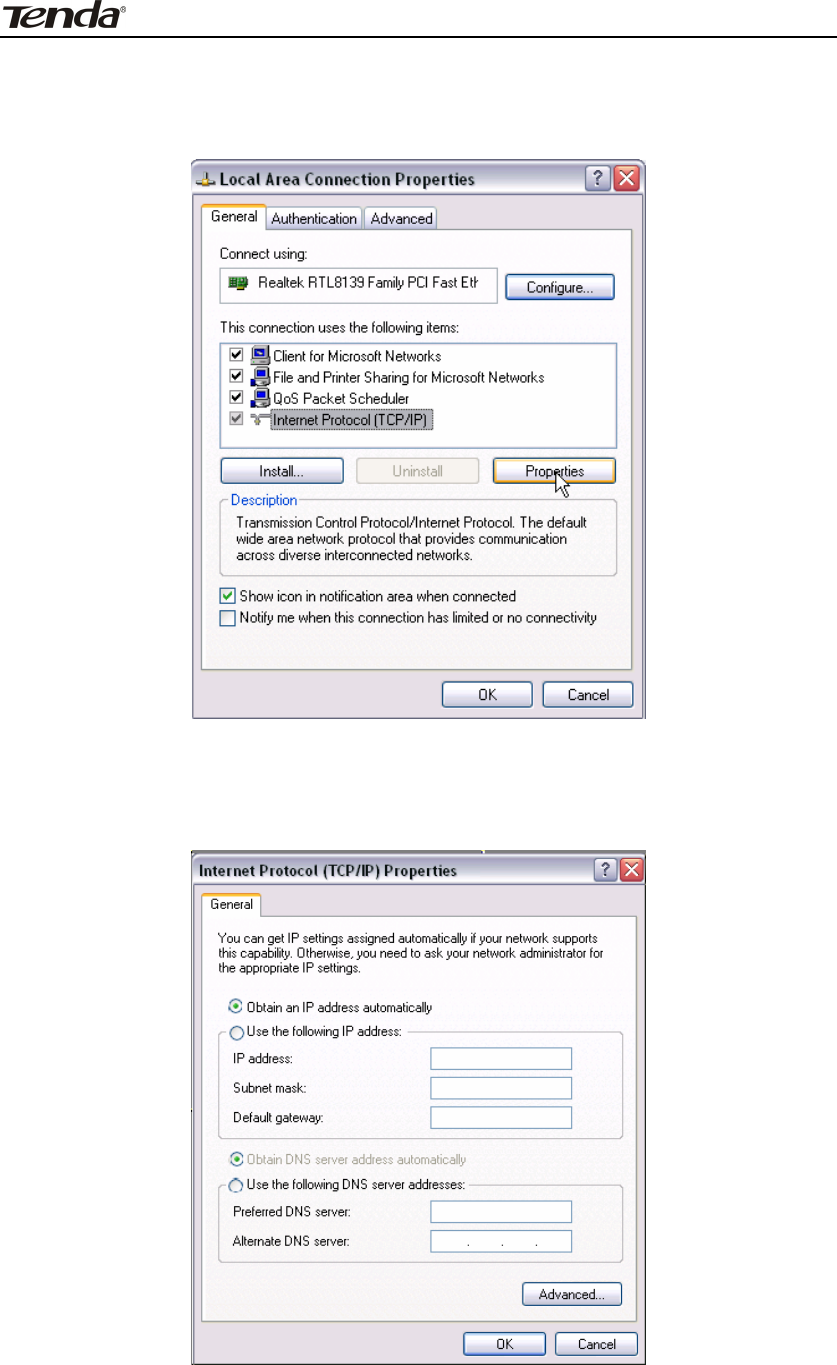
Concurrent Dual Band Wireless N600 Gigabit Router
3. Select “Internet Protocol (TCP/IP)” on the appearing window and click
“Properties” button.
4. Select “Use the following IP address” or “Obtain an IP address automatically”.
a. To “Obtain an IP address automatically” simply click the corresponding button.
67

Concurrent Dual Band Wireless N600 Gigabit Router
b. “Use the following IP address”
IP address: Enter 192.168.0.xxx (xxx can be any value from 2~254).
Subnet mask: Enter 255.255.255.0.
Default gateway: Enter 192.168.0.1.
Preferred DNS server: Enter 192.168.0.1 in case that you don’t know the local DNS
server address (Or contact your ISP for help).
At last, click OK to save your settings.
Windows7
If you are using Windows 7 operating system, do as follows:
1. Right click “Network” on your desktop and select “Properties”.
2. Click “Change adapter settings”.
3. Right click “Local Area Connection” and select “Properties”.
68
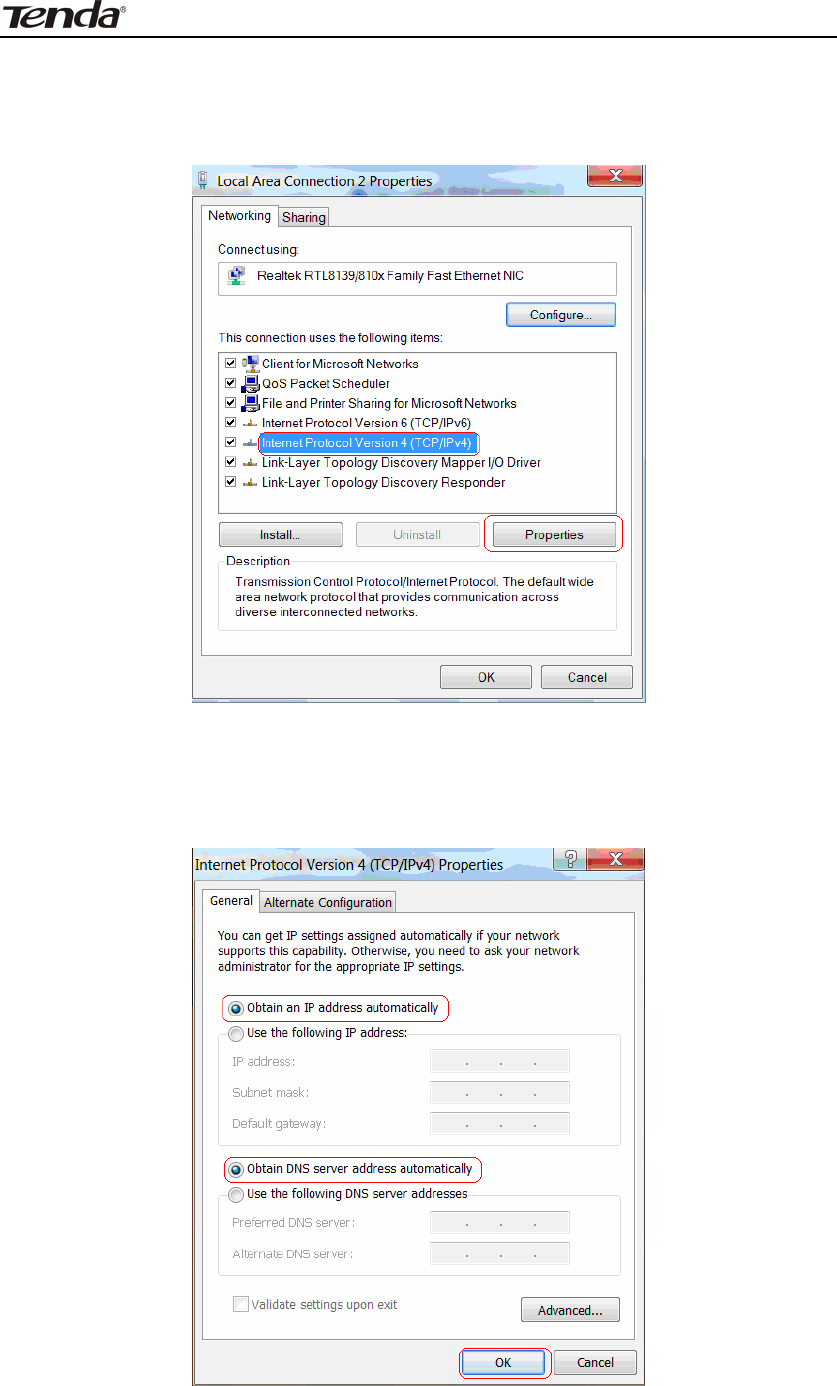
Concurrent Dual Band Wireless N600 Gigabit Router
3. Select “Internet Protocol (TCP/IP)” on the appearing window and click the
“Properties” button.
5. Select “Use the following IP address” or “Obtain an IP address automatically”.
a. To “Obtain an IP address automatically” simply click the corresponding button.
69

Concurrent Dual Band Wireless N600 Gigabit Router
b. “Use the following IP address”
IP address: Enter 192.168.0.xxx (xxx can be any value from 2~254).
Subnet mask: Enter 255.255.255.0.
Default gateway: Enter 192.168.0.1.
Preferred DNS server: Enter 192.168.0.1 in case that you don’t know the local DNS
server address (Or contact your ISP for help).
At last, click OK to save your settings.
70

Concurrent Dual Band Wireless N600 Gigabit Router
FCC Statement
Operations in the 5.15-5.25GHz band are restricted to indoor usage only.
This device complies with Part 15 of the FCC Rules. Operation is subject to the
following two conditions: (1) This device may not cause harmful interference, and
(2) this device must accept any interference received, including interference that
may cause undesired operation.
This equipment has been tested and found to comply with the limits for a Class B
digital device, pursuant to Part 15 of the FCC Rules. These limits are designed to
provide reasonable protection against harmful interference in a residential
installation. This equipment generates, uses and can radiate radio frequency
energy and, if not installed and used in accordance with the instructions, may
cause harmful interference to radio communications. However, there is no
guarantee that interference will not occur in a particular installation. If this
equipment does cause harmful interference to radio or television reception, which
can be determined by turning the equipment off and on, the user is encouraged to
try to correct the interference by one of the following measures:
- Reorient or relocate the receiving antenna.
- Increase the separation between the equipment and receiver.
- Connect the equipment into an outlet on a circuit different from that to which
the receiver is connected.
- Consult the dealer or an experienced radio/TV technician for help.
FCC Caution: Any changes or modifications not expressly approved by the party
responsible for compliance could void the user's authority to operate this
equipment.
This transmitter must not be co-located or operating in conjunction with any other
antenna or transmitter.
71

Concurrent Dual Band Wireless N600 Gigabit Router
Radiation Exposure Statement
This equipment complies with FCC radiation exposure limits set forth for an
uncontrolled environment. This equipment should be installed and operated with
minimum distance 20cm between the radiator & your body.
NOTE: (1)The manufacturer is not responsible for any radio or TV interference
caused by unauthorized modifications to this equipment.(2) To avoid unnecessary
radiation interference, it is recommended to use a shielded RJ45 cable
CE Mark Warning
Operations in the 5.15-5.25GHz band are restricted to indoor usage only.
This is a Class B product in a domestic environment, this product may cause radio
interference, in which case the user may be required to take adequate measures
NOTE: (1) The manufacturer is not responsible for any radio or TV interference
caused by unauthorized modifications to this equipment. (2) To avoid unnecessary
radiation interference, it is recommended to use a shielded RJ45 cable
"The product can be used without restrictions in the following countries: all EU
member states except France and Norway.
The product can be used with limitations in the following countries: France (for
indoor use only) and Norway (20 km in the center of Ny-Ĺlesund)."
Safety Instructions
1.Operation temperature range:0-40℃
2.For applicable power supplies see user manual
Adapter information:
Model:TEA09X-09100 or TEA12X-12150 (X=A or E or U or D)
Input: 100-240V,50/60Hz,0.3A
3. USB output:5Vdc,0.5A
72